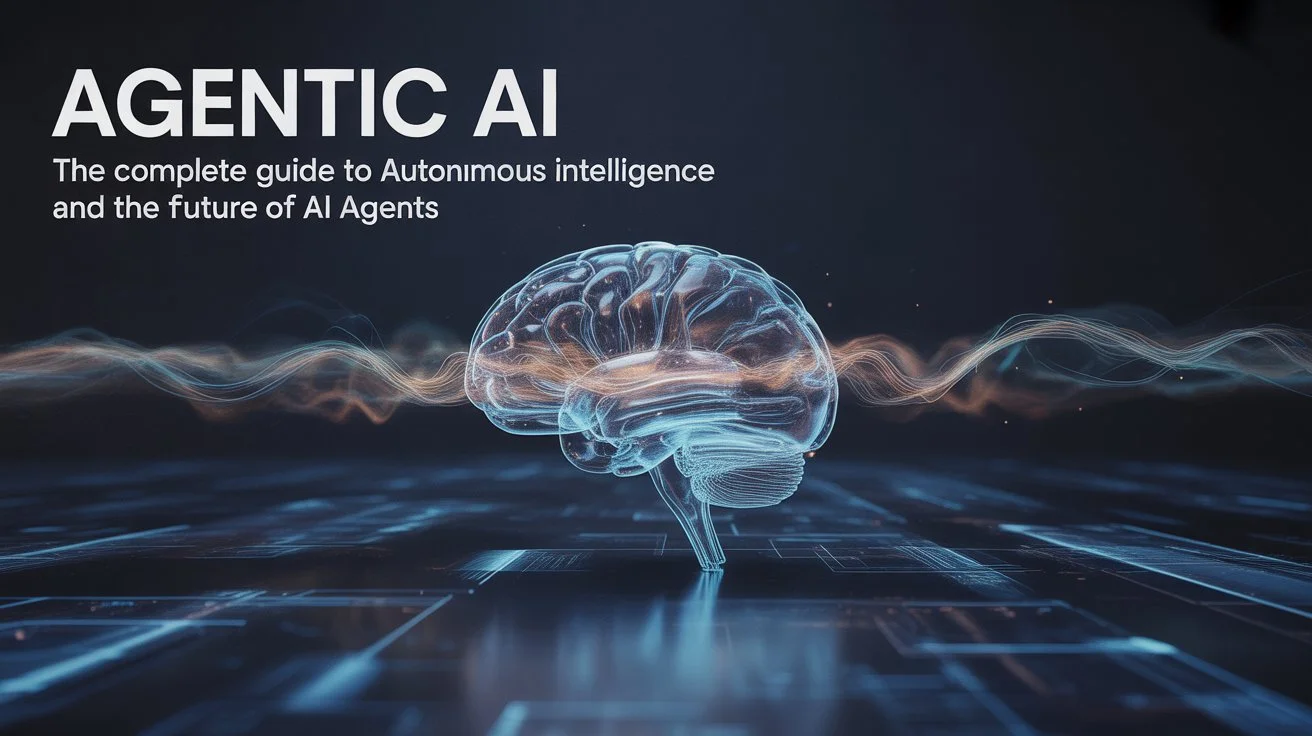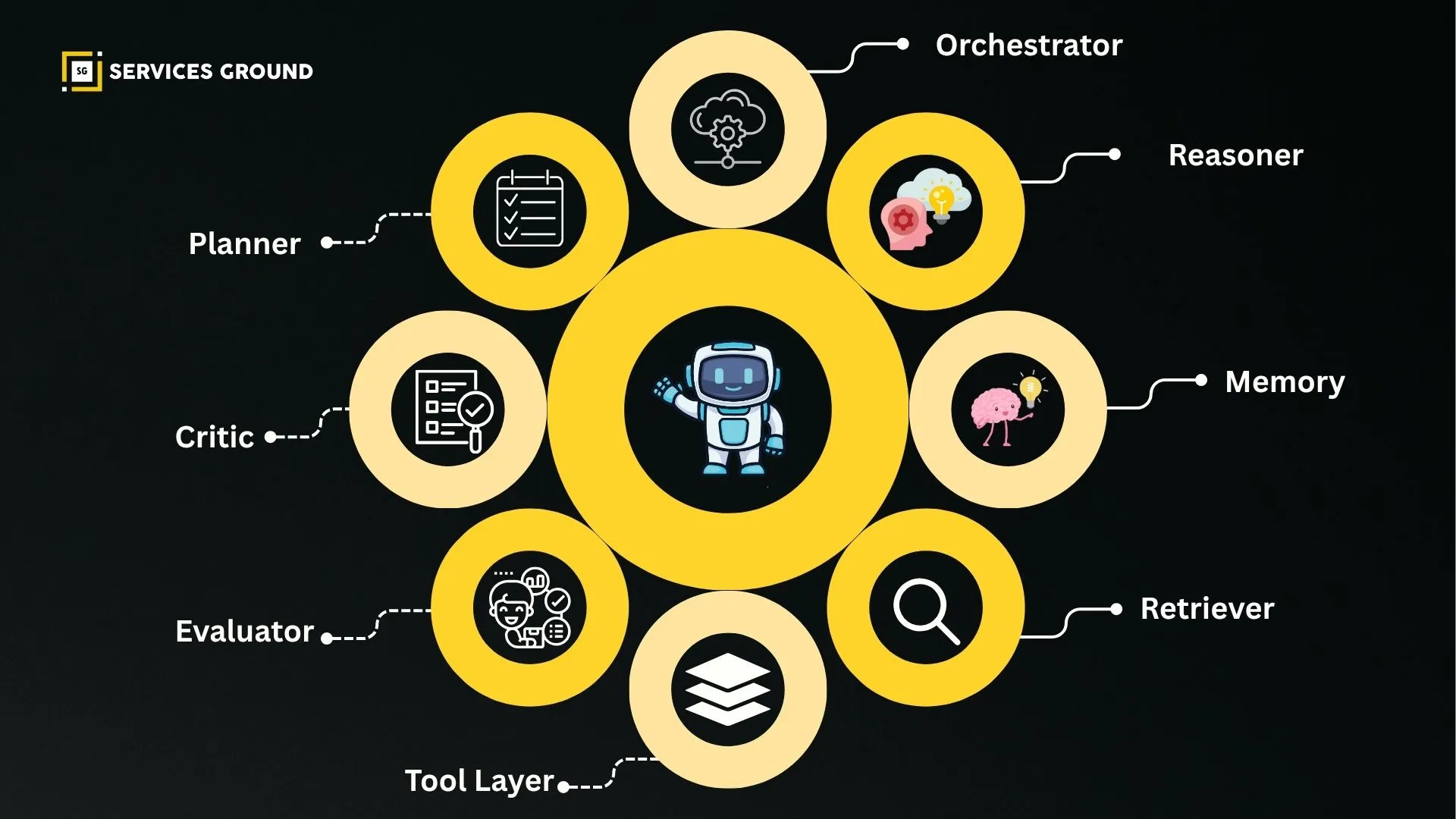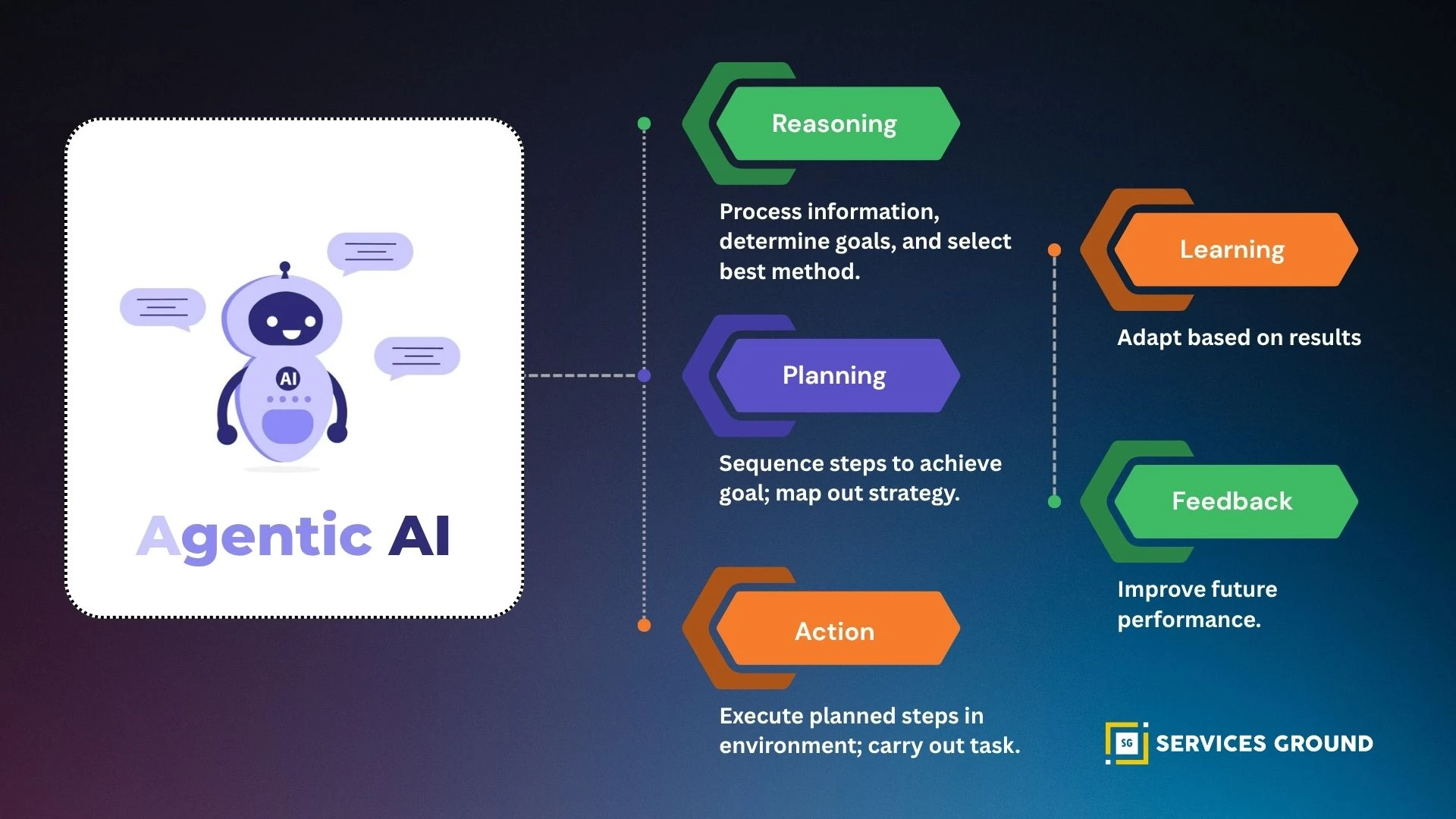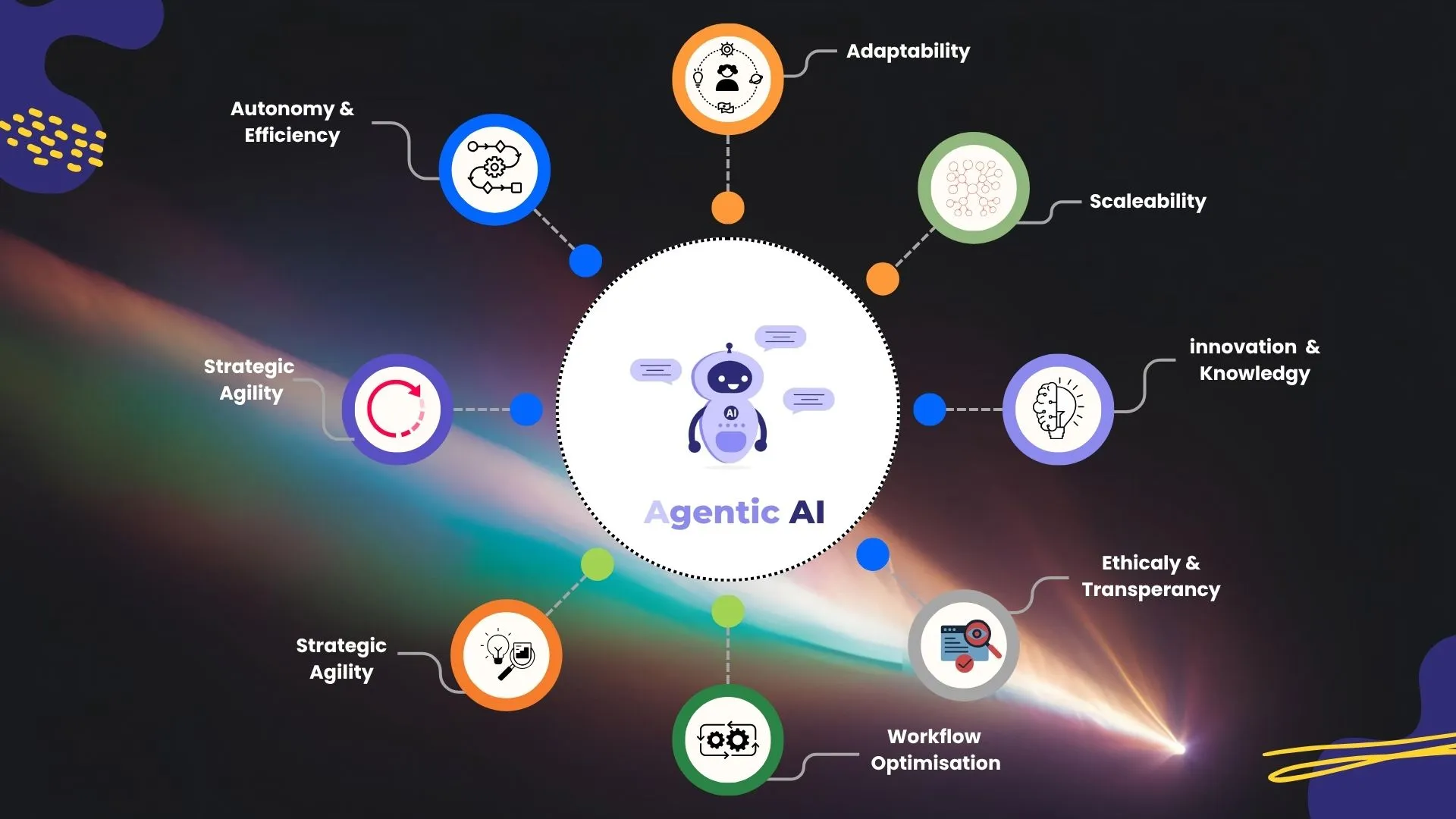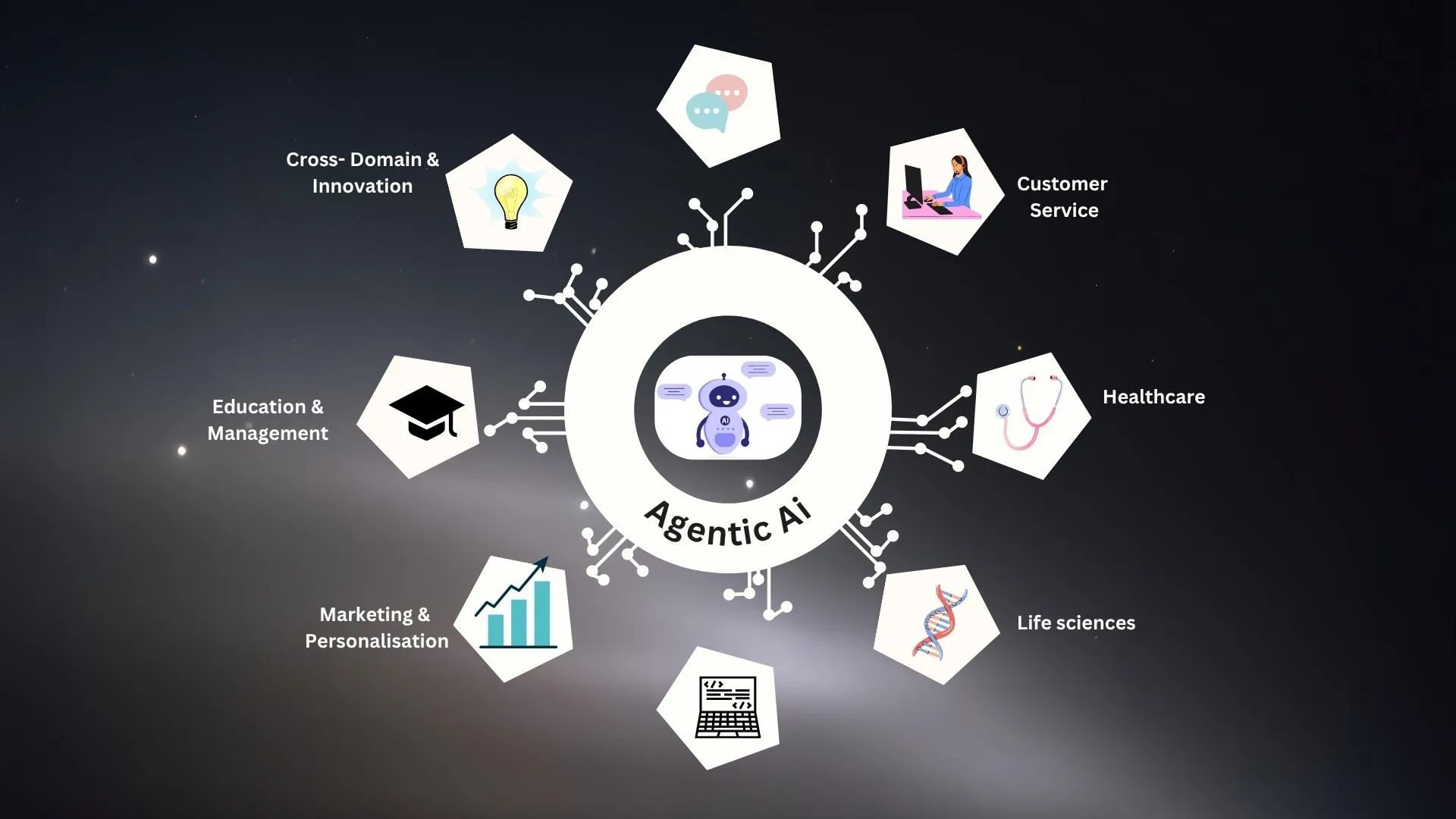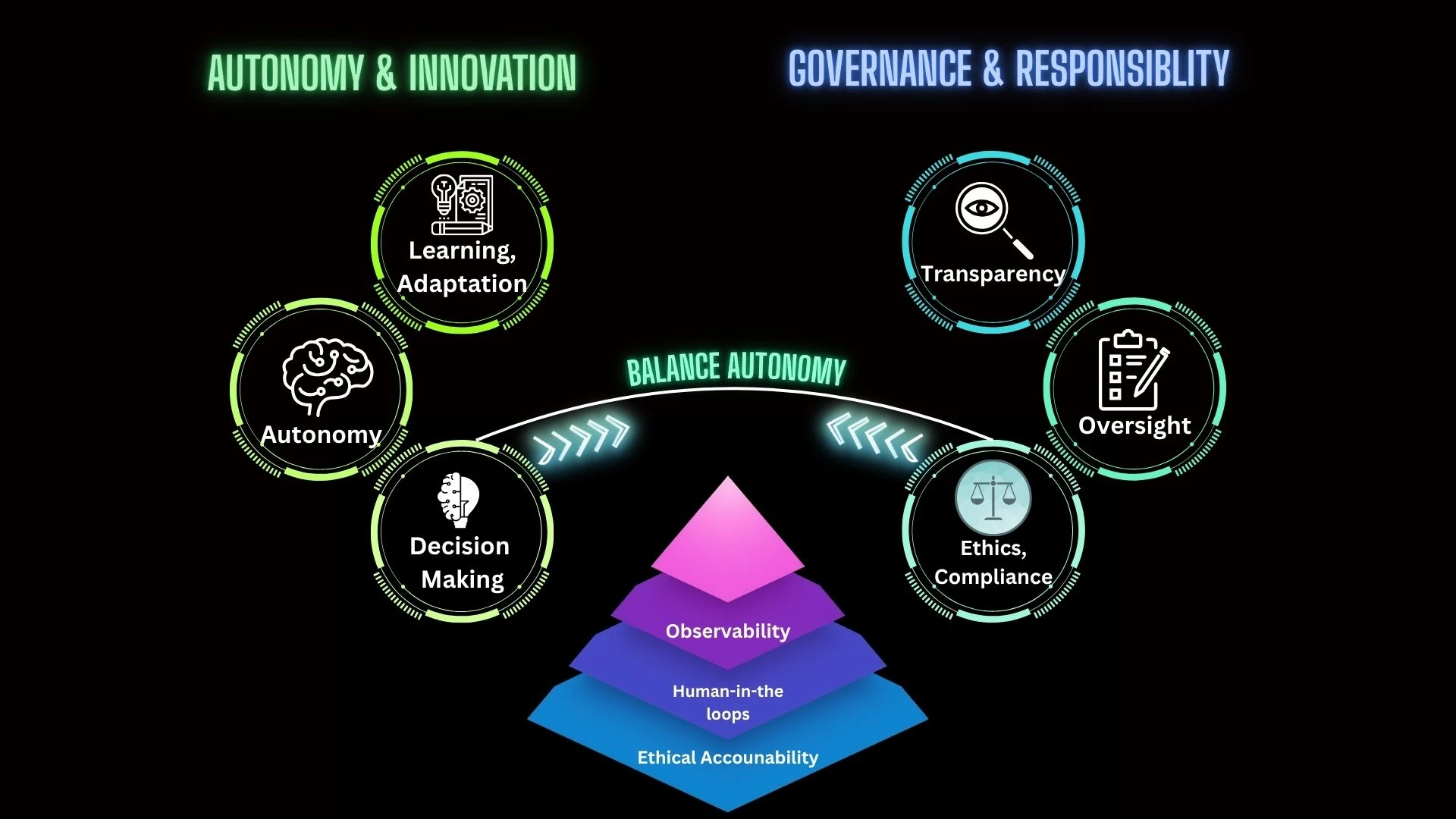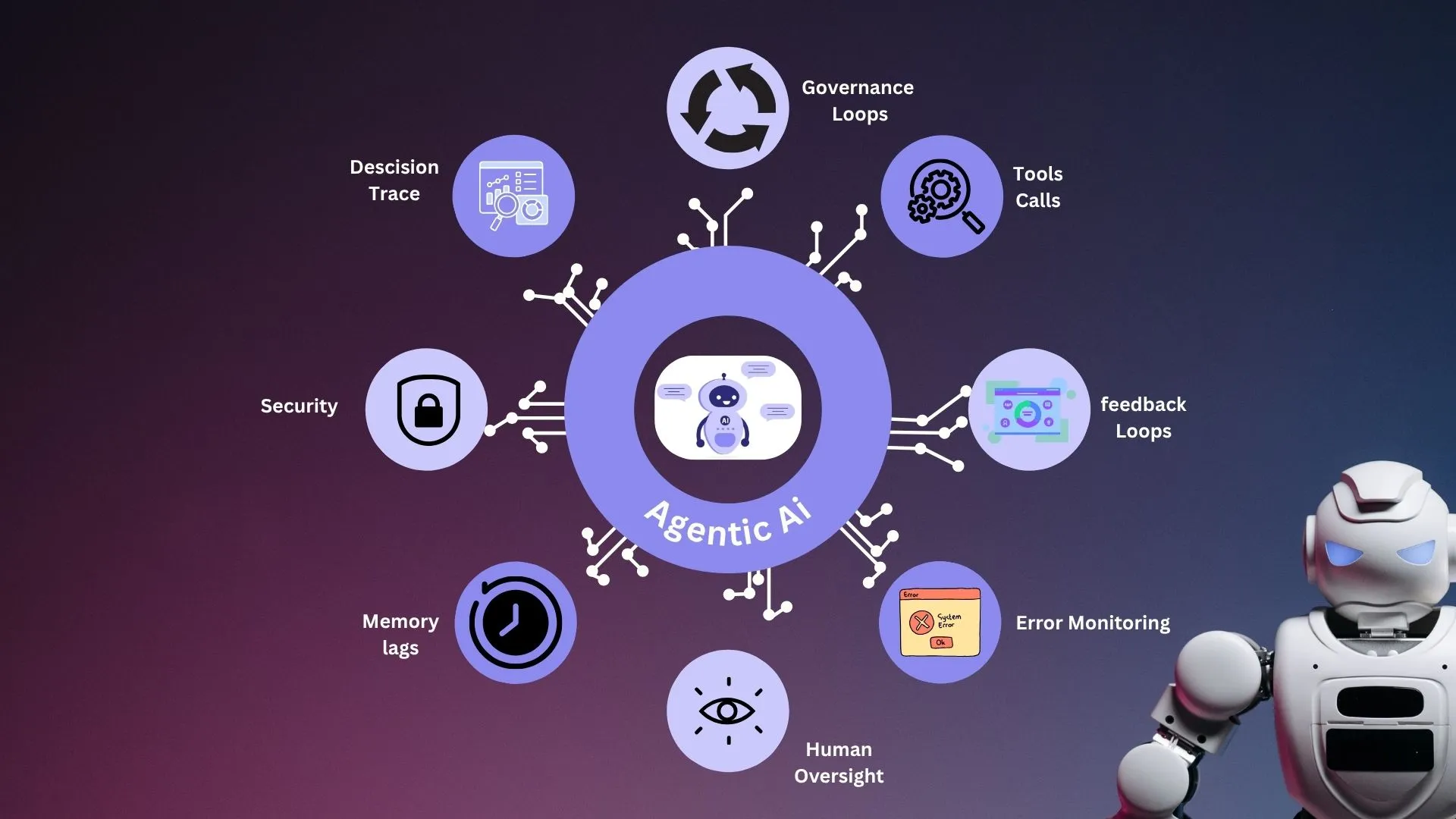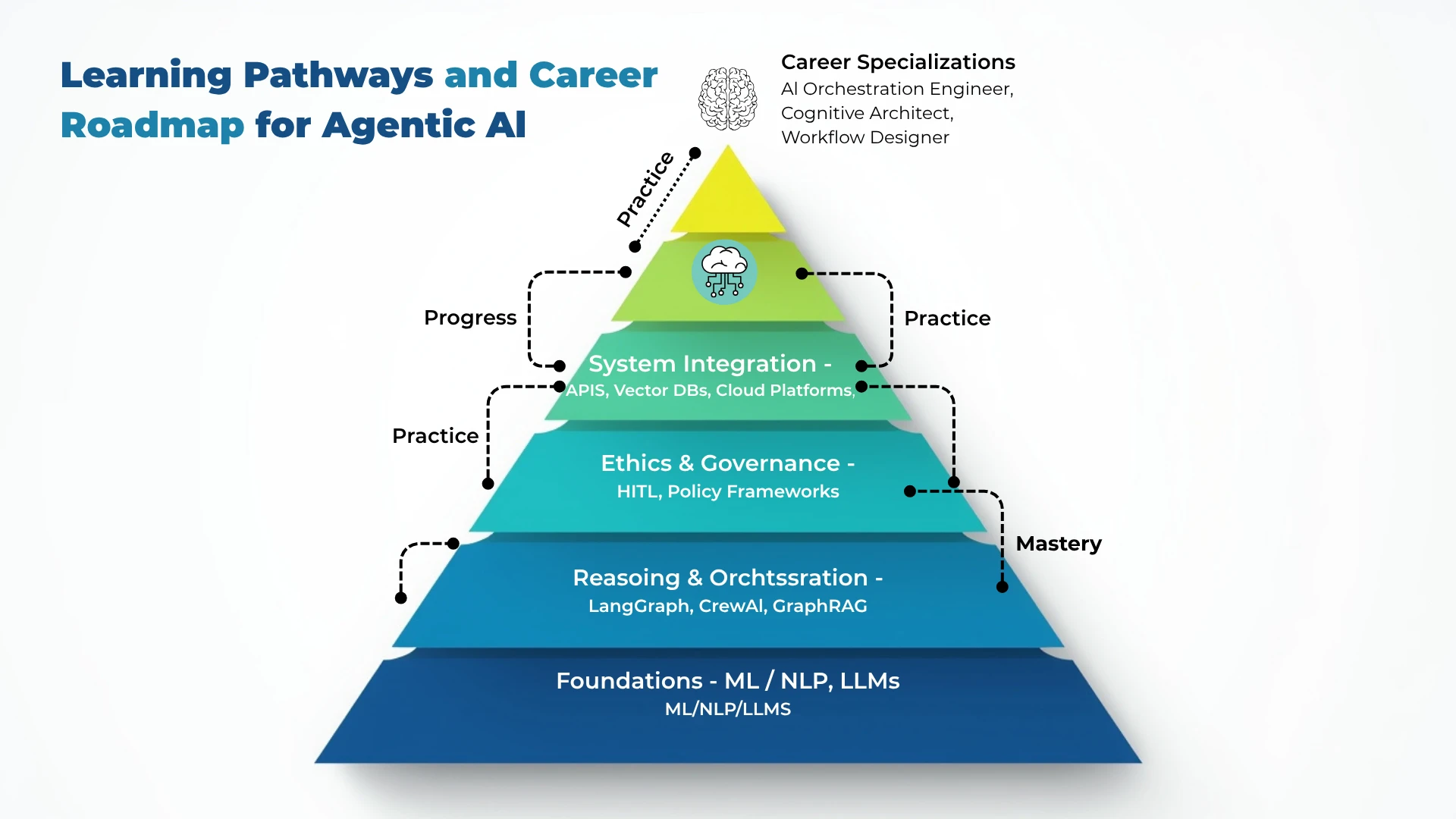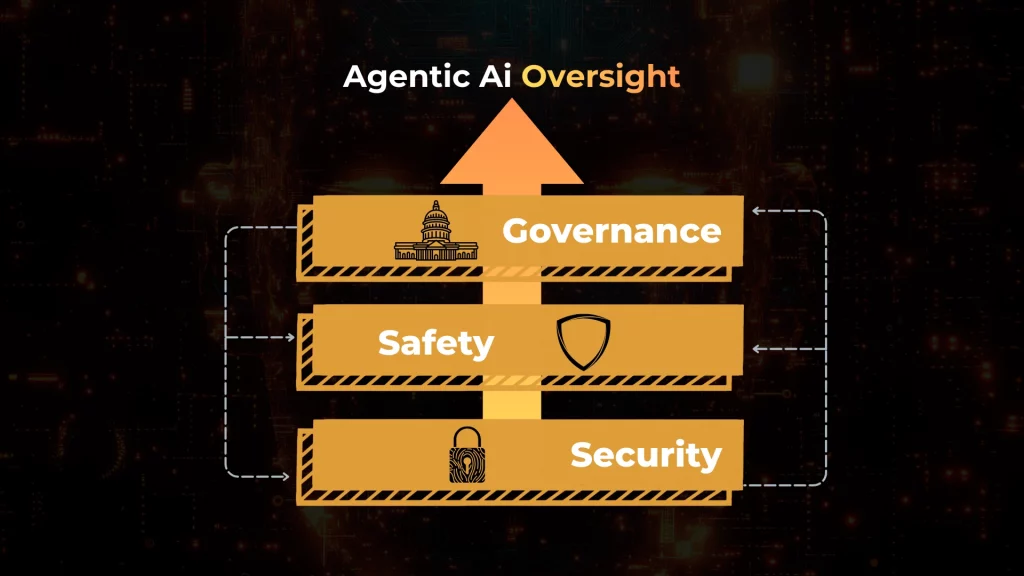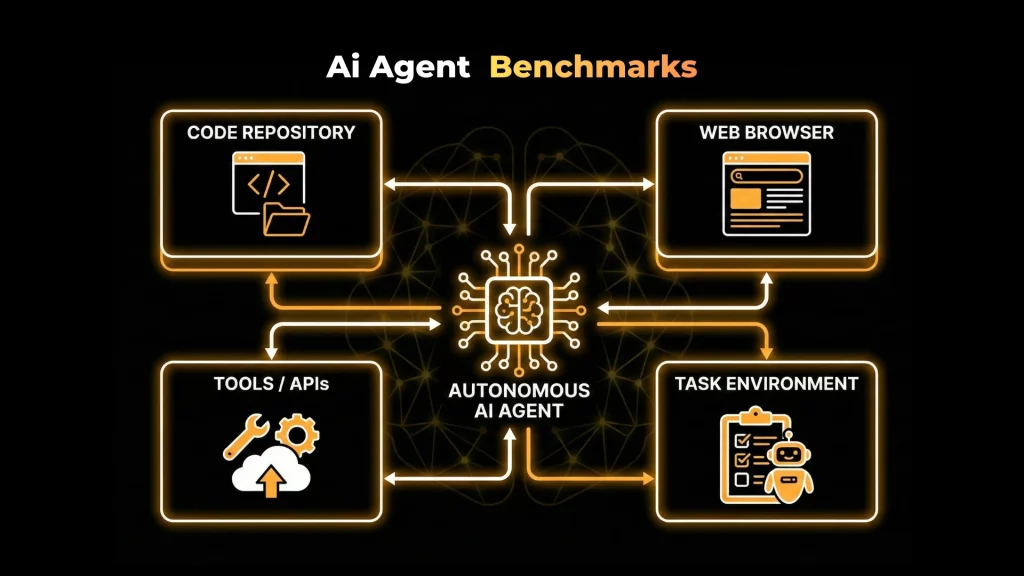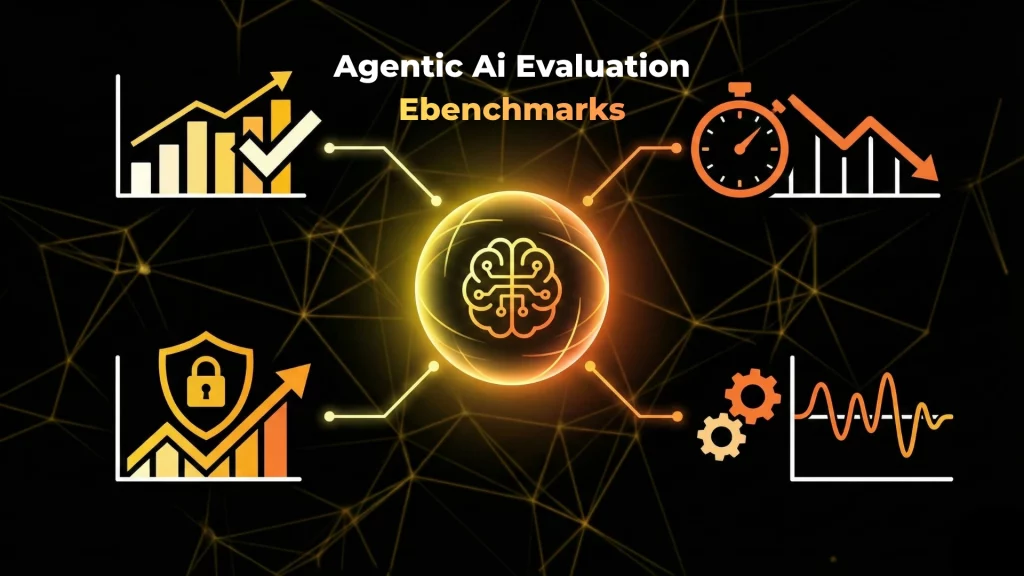Introduction — The Next Evolution in Artificial Intelligence
From Automation to Autonomy
Artificial intelligence (AI) has reached a critical inflection point. For decades, AI systems were largely reactive, analyzing structured data, forecasting trends, or automating repetitive operations. These technologies, though impressive, were bound by human-defined parameters. They could predict, generate, or classify, but not act with purpose.
Today, we are witnessing a transformative shift from automation to autonomy. AI is no longer confined to preprogrammed logic. A new generation of intelligent systems can reason, plan, and adapt within dynamic environments. This shift represents a fundamental change in how machines interact with information and the world around them.
This next frontier is known as Agentic AI, the evolution from passive computation to purposeful autonomy.
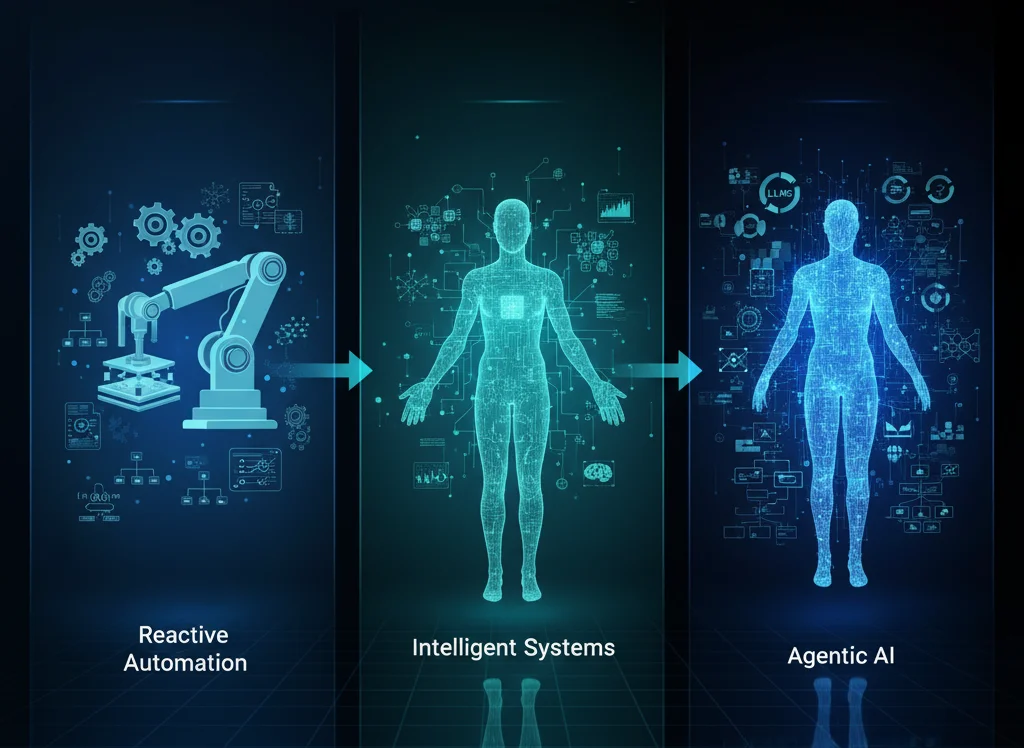
What Defines Agentic AI?
Agentic AI represents an advanced form of artificial intelligence designed to make independent decisions, pursue goals, and continuously learn with minimal human intervention.
Rather than reacting to prompts or static instructions, agentic systems understand context, break objectives into sub-tasks, and coordinate actions across tools, data sources, and networks.
At its core, Agentic AI is powered by three foundational technologies:
- Large Language Models (LLMs): These serve as the cognitive engine, enabling reasoning, understanding, and communication through natural language.
- Machine Learning (ML): The adaptive layer that helps agents recognize patterns, evaluate performance, and improve through feedback.
Orchestration Frameworks: The operational backbone that manages how agents plan, execute, and synchronize actions ensuring stability and scalability across complex systems.
Together, these components enable the Perception–Reasoning–Action loop, the same cognitive cycle that underpins human intelligence. Through this loop, Agentic AI systems can gather information, interpret it, take action, and refine their behavior based on results.
The Psychology Behind the Term “Agentic”
The term “Agentic” originates from psychology, specifically the concept of agency and the ability to act intentionally toward a goal.
When applied to artificial intelligence, it signifies more than automation; it embodies purpose-driven behavior.
An AI agent is, in essence, a digital entity capable of self-directed action.
In psychology, agency is tied to motivation, decision-making, and accountability. In AI, these principles translate into goal orientation, adaptive learning, and contextual reasoning. Thus, an agentic system doesn’t merely follow rules; it understands why it is performing an action and how that action aligns with its intended outcome.
By integrating the human-like quality of agency into computational systems, we move closer to building AI that mirrors our cognitive flexibility, judgment, and intentionality.
Why Agentic AI Marks a Paradigm Shift
This rise of Agentic AI marks one of the most significant paradigm shifts in the evolution of technology.
Unlike earlier generations of AI that required constant human supervision, these systems demonstrate autonomy, situational awareness, and continuous self-improvement.
In practical terms, this means an agentic system can:
- Analyze live environments and adjust its actions in real time.
- Collaborate with other agents or tools to solve complex tasks.
- Learn from success and failure to enhance its future performance.
For organizations, Agentic AI introduces a new strategic layer, one where decision-making, execution, and optimization occur simultaneously and adaptively.
This shift from instruction-based automation to goal-oriented autonomy is redefining productivity, governance, and innovation across industries.
The Foundation for the Next Era of AI
As researchers and enterprises explore the capabilities of Agentic AI, it’s clear that this isn’t just another technological upgrade, it’s a redefinition of intelligence itself.
Agentic systems transform artificial intelligence from being a tool into a collaborative one capable of understanding objectives, taking initiative, and learning continuously.
This foundational change will influence every future domain of AI, from Generative AI and Reinforcement Learning to multi-agent orchestration and cognitive computing.
Agentic AI is not about replacing human intelligence; it’s about augmenting it by empowering humans to focus on creativity, ethics, and high-level reasoning while agents handle complexity and execution.
As we stand on the threshold of this new era, Agentic AI is poised to reshape how we build, deploy, and trust artificial intelligence, forming the bedrock for an autonomous and adaptive future.
From Predictive to Generative to Agentic AI
The Three Eras of Artificial Intelligence
Every significant leap in artificial intelligence (AI) marks a new era in machine cognition each stage evolving toward greater autonomy and contextual understanding.
From Predictive AI, which could anticipate outcomes, to Generative AI, which could create new content, and now to Agentic AI, which can act independently, the journey reflects how machines are gradually acquiring agency, adaptability, and decision-making capability.
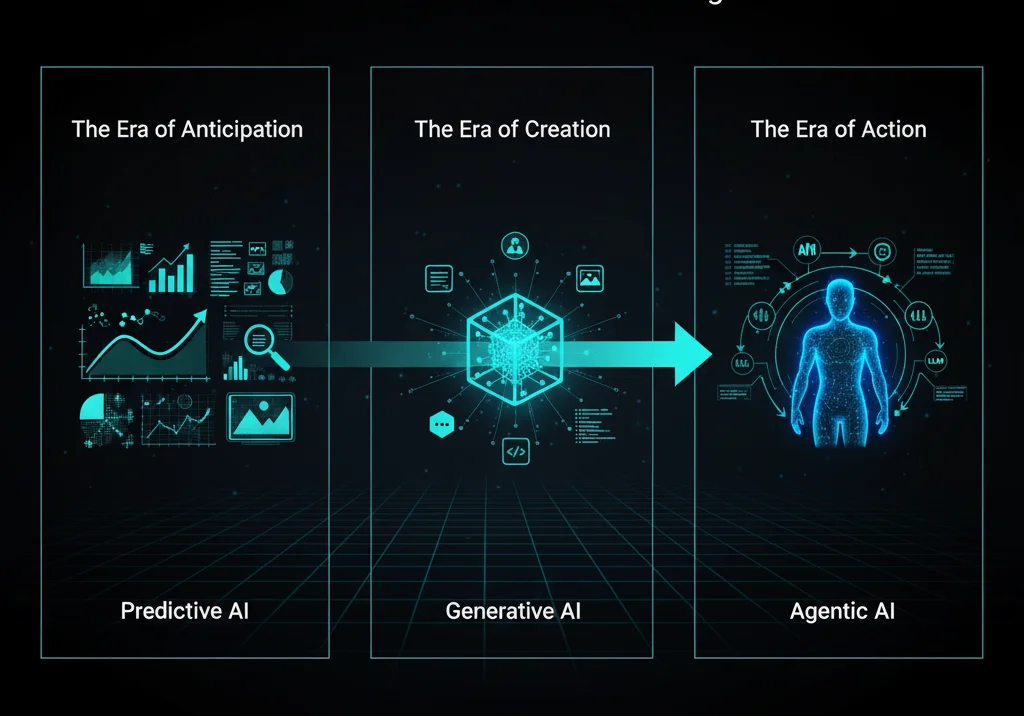
Predictive AI — The Era of Anticipation
The first major milestone in the evolution of AI was Predictive AI, which focused on forecasting and pattern recognition.
By analyzing vast amounts of historical and real-time data, these systems learned to predict outcomes before they occurred.
Common examples include:
- Recommendation engines predicting what movie or product a user might prefer.
- Predictive maintenance systems detecting when industrial equipment is likely to fail.
- Fraud detection algorithms spotting unusual financial transactions.
Predictive AI operates on statistical and probabilistic models such as regression, decision trees, or deep neural networks to identify correlations within structured datasets.
It answers the question: “What is likely to happen next?”
However, while predictive systems could foresee outcomes, they lacked the ability to create, reason, or adapt beyond their programmed purpose.
They served as decision-support tools, not decision-makers.
Generative AI — The Era of Creation
The next evolutionary leap came with Generative AI, which shifted from prediction to creation.
Fueled by breakthroughs in Transformer architectures and Large Language Models (LLMs) like GPT, Claude, and Gemini, these systems learned not just to analyze data but to generate text, code, visuals, and even sound.
Generative AI marked the rise of models that could:
- Write essays, articles, or code using natural language understanding.
- Generate images, music, and videos from text prompts.
- Assist professionals in marketing, design, and software development through AI co-pilots.
Where Predictive AI answered “what might happen,” Generative AI answered “what can we create?”
Its main strength lies in pattern synthesis — using learned data distributions to generate new, coherent content that resembles human output.
However, Generative AI is still reactive by design. It waits for a human prompt and does not initiate actions or make decisions on its own.
It lacks goal orientation, tool interaction, and situational awareness, the defining traits of the next era: Agentic AI.
Agentic AI — The Era of Action
Agentic AI represents the third and most advanced phase of artificial intelligence moving from creating to doing.
These systems combine the predictive power of machine learning with the creative intelligence of generative models, then extend it with autonomy, reasoning, and goal-driven behavior.
An Agentic AI system is capable of:
- Observation – Perceiving its environment through sensors, APIs, or data inputs.
- Reasoning – Using contextual understanding and decision-making frameworks to evaluate multiple options.
- Action – Executing tasks, triggering workflows, or collaborating with other agents or tools.
- Reflection and Learning – Continuously improving its strategies based on feedback and outcomes.
Unlike predictive and generative models, agentic systems operate in closed feedback loops, where every action informs the next.
They are proactive, not reactive, capable of long-term planning, adaptation, and cross-domain problem solving.
Where Generative AI stops at producing, Agentic AI continues by executing and improving.
This shift transforms AI from a tool that supports human decision-making into an intelligent partner capable of autonomous operation.
Comparing the Three AI Paradigms
| Feature | Predictive AI | Generative AI | Agentic AI |
|---|---|---|---|
| Primary Function | Forecast outcomes | Create new content | Act toward goals |
| Data Dependency | Structured, historical data | Massive, unstructured datasets | Dynamic, real-time data |
| Learning Model | Statistical and ML models | Transformer-based deep learning | Reinforcement learning, planning, reasoning |
| Human Involvement | High | Medium | Low |
| Autonomy Level | Reactive | Creative but prompt-driven | Independent and goal-directed |
| Output Type | Predictions | Generated content | Actions, decisions, workflows |
| Examples | Netflix recommendations, spam filters | ChatGPT, Midjourney, GitHub Copilot | LangGraph Agents, CrewAI Systems, Semantic Kernel Agents |
This comparative view highlights the progressive autonomy of AI systems from predicting, to generating, to acting.
Each stage doesn’t replace the previous one; rather, they build upon one another, forming a cumulative hierarchy of intelligence.
Why the Transition Matters
Understanding this progression isn’t just academic, it’s essential for anticipating how organizations will operate in the future.
- Predictive AI gave businesses insight.
- Generative AI gave them creativity.
- Agentic AI gives them execution and autonomy.
By integrating reasoning, planning, and adaptive learning, Agentic AI systems close the gap between analysis and action.
They not only understand human intent but also have the capacity to act on it transforming AI from an assistive tool into an operational collaborator.
This evolution sets the stage for a future where digital systems function as autonomous teammates, capable of driving business processes, scientific discovery, and creative problem-solving all with minimal human intervention.
What Is Agentic AI?
Defining Agentic AI
Agentic AI is a form of artificial intelligence designed to act autonomously, reason contextually, and pursue specific goals without constant human oversight.
It moves beyond generating outputs to making decisions, executing actions, and improving its behavior through feedback loops.
Unlike rule-based or generative models, Agentic AI introduces agency the ability to make informed choices aligned with predefined objectives.
In practical terms, an agentic system behaves more like a collaborator than a tool, interpreting human intent and acting purposefully to achieve desired outcomes.
Agentic AI systems represent the convergence of three technological layers:
- Large Language Models (LLMs) provide natural language understanding and reasoning.
- Machine Learning (ML) enables continuous adaptation and pattern recognition.
- Orchestration Frameworks allow multiple agents to plan, coordinate, and execute workflows across tools and systems.
This fusion allows Agentic AI to operate with a form of computational intent a machine’s capacity to act with purpose.
The Core Attributes of Agentic Systems
Agentic systems exhibit several defining characteristics that distinguish them from previous AI paradigms:
- Autonomy — They perform tasks independently with minimal supervision, enabling true self-directed operation.
- Goal Orientation — Each agent is programmed to achieve explicit objectives and measure progress dynamically.
- Adaptability — Through reinforcement learning and feedback, agents improve their performance continuously.
- Context Awareness — They interpret data within environmental and conversational context, not in isolation.
- Reasoning Capability — They can evaluate multiple solutions, weigh trade-offs, and select optimal paths.
- Collaboration — They can work with other agents, humans, and systems to solve complex problems collectively.
- Explainability — Modern frameworks emphasize interpretable reasoning paths so humans can audit agent decisions.
Together, these traits create systems that don’t simply compute they think, plan, and act.
The Building Blocks of Agentic AI
Agentic AI operates as an ecosystem of interconnected modules, each performing a distinct role in the perception–reasoning–action process.
| Component | Function | Example Entities / Tools |
|---|---|---|
| Planner | Defines goals and breaks them into actionable steps. | Workflow planners, Task graphs |
| Reasoner | Makes decisions based on logic and data context. | LLMs, ReAct frameworks |
| Memory | Stores knowledge, past actions, and environmental data. | Vector databases (Pinecone, FAISS, Weaviate) |
| Retriever | Finds relevant information from knowledge sources. | RAG pipelines, Semantic search |
| Tool Layer | Executes functions via APIs or integrations. | LangChain tools, CrewAI connectors |
| Critic / Evaluator | Reviews and refines outputs for accuracy. | Reflexion agents, Self-critique loops |
| Orchestrator | Manages multi-agent coordination. | LangGraph, Semantic Kernel |
Each component is modular and interoperable, enabling flexible architectures that scale from a single AI agent to distributed multi-agent ecosystems.
The Cognitive Roots of Agency in AI
The word “agentic” originates from the psychological concept of agency, the human ability to act intentionally toward goals.
When transposed into AI, it describes a system capable of self-determined behavior within defined boundaries.
From a cognitive perspective:
- Agency implies initiative, reasoning, and responsibility.
- In AI, it represents autonomy, feedback learning, and accountability mechanisms.
- Together, these attributes give machines a form of “artificial volition” goal-driven action governed by constraints and objectives.
This psychological underpinning gives Agentic AI a conceptual depth that connects human cognition with computational autonomy making it more relatable and ethically interpretable.
Agentic AI as a System of Collaboration
Agentic AI systems rarely work in isolation.
They function as part of a multi-agent architecture, where specialized agents collaborate to achieve collective goals.
For example:
- One agent may focus on retrieving data, another on analyzing results, and another on executing actions or monitoring outcomes.
- These agents communicate and coordinate through shared memory and orchestration frameworks, forming a digital ecosystem of intelligent collaboration.
This architecture enables scalability intelligence distributed across agents, each specialized yet connected.
The result is an adaptive, resilient AI system capable of solving dynamic, cross-domain challenges.
Why Agentic AI Matters
Agentic AI is not just a technical upgrade it’s a conceptual transformation.
It redefines how we think about intelligence, labor, and decision-making in the digital era.
By granting AI systems the ability to reason, plan, and act, organizations can:
- Automate complex workflows that previously required human cognition.
- Enable 24/7 operational intelligence that continuously learns and adapts.
- Reduce bottlenecks between insight and execution.
- Build hybrid systems where humans focus on creativity and strategy while agents handle execution.
This convergence of autonomy and collaboration represents a new phase of enterprise intelligence, one where AI becomes a trusted co-worker, not just a computational engine.
How Agentic AI Works — The Perception–Reasoning–Action Loop
The Cognitive Blueprint Behind Agentic AI
Every agentic system follows a loop inspired by how humans think and act.
This Perception–Reasoning–Action (PRA) cycle gives AI agents the ability to sense, analyze, decide, act, and learn.
Rather than executing predefined scripts, these systems interact with their environments, observe outcomes, and refine their behavior over time.
It’s what transforms static computation into adaptive cognition.
Stage 1 — Perception: Sensing and Understanding the Environment
Perception is the foundation of intelligence.
An AI agent begins by observing its surroundings collecting structured and unstructured data through APIs, sensors, documents, or conversations.
This raw information is transformed into context through:
- Natural Language Processing (NLP): to interpret human language inputs.
- Computer Vision: to analyze images, video, or sensor data.
- Knowledge Graphs and Ontologies: to connect entities and relationships semantically.
- Retrieval-Augmented Generation (RAG): to bring external knowledge into reasoning.
Through these perception layers, the agent filters noise, identifies key variables, and builds a working model of its environment in what in cognitive science would be called situational awareness.
Stage 2 — Reasoning: Contextual Decision-Making
Once perception provides data, the system moves to reasoning the stage that separates Agentic AI from rule-based automation.
Here, the agent engages in logical deliberation to decide what actions best serve its goal.
Common reasoning frameworks include:
- ReAct (Reason + Act): alternating thought and action steps.
- Tree of Thoughts (ToT): exploring multiple possible solution paths.
- Reflexion: evaluating and improving its own intermediate results.
- Critic-Refine: adding self-review through a secondary evaluator agent.
The reasoning engine often relies on LLMs combined with reinforcement-learning feedback to weigh evidence, test hypotheses, and prioritize next steps.
It answers the question: “What should I do next and why?”
Stage 3 — Planning: Structuring the Path to a Goal
Before acting, the agent creates a plan a hierarchical roadmap of tasks and subtasks.
Using planning algorithms drawn from decision theory and reinforcement learning, it breaks broad objectives into executable sequences.
Key planning components include:
- Task Decomposition: dividing complex objectives into achievable actions.
- Dependency Mapping: identifying which actions must occur in what order.
- Temporal Optimization: scheduling and resource allocation for efficiency.
Frameworks like LangGraph or Semantic Kernel handle this orchestration layer, ensuring that each agent understands its role and the dependencies among them.
Stage 4 — Action: Execution and Interaction
At this point, the agent acts.
It performs concrete operations through tool use, API calls, or system commands, integrating seamlessly with enterprise platforms such as CRM, ERP, or code repositories.
These interactions may include:
- Generating and submitting reports or code.
- Executing data queries or system updates.
- Communicating with other agents to delegate tasks.
Modern frameworks emphasize safe execution environments sandboxing, access control, and observability to ensure the agent acts within defined parameters.
This is where digital reasoning turns into tangible output.
Stage 5 — Learning and Feedback: Continuous Improvement
Every action produces data.
Agentic AI captures results, compares them with expected outcomes, and refines future behavior.
This continuous feedback loop forms the basis of self-optimization.
Learning mechanisms include:
- Reinforcement Learning (RL): rewarding successful actions and penalizing failures.
- Memory Persistence: storing outcomes, context windows, and reflections for reuse.
- Performance Metrics: evaluating accuracy, efficiency, and reliability.
Over time, the agent develops, experience a knowledge base that enhances reasoning and prediction.
This mirrors how humans learn through trial and reflection, closing the cognitive loop that defines true autonomy.
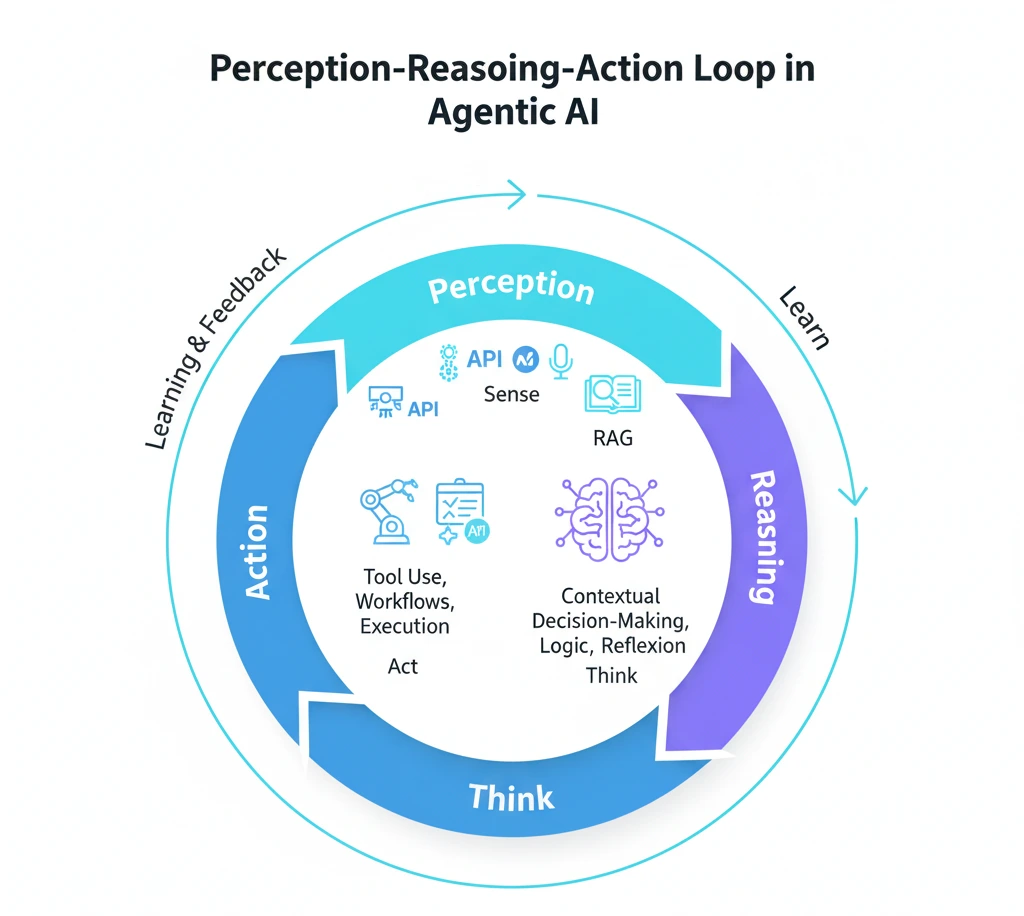
Integrating the PRA Loop Across Multi-Agent Systems
In large-scale environments, hundreds of agents may execute PRA loops simultaneously.
An orchestrator (e.g., LangGraph or CrewAI) synchronizes these cycles, manages dependencies, and prevents conflicting actions.
Memory sharing and message passing enable collective intelligence: one agent’s learning becomes another’s context.
This distributed cognition allows enterprises to scale intelligence the same way they scale computing.
Why the Loop Matters
The Perception–Reasoning–Action Loop is the operational heart of Agentic AI.
It ensures that intelligence isn’t static but continuously adaptive.
Where traditional automation follows instructions, agentic systems observe, reason, and evolve bridging the gap between human intention and machine execution.
For organizations, implementing PRA-driven systems means:
- Faster, context-aware decision cycles.
- Reduced manual intervention in dynamic workflows.
- Continuous improvement without re-training from scratch.
This mechanism turns AI from a passive analyst into an active participant in achieving business goals.
The Architecture of Agentic Systems
Understanding the Structural Blueprint
At its core, an agentic architecture is a layered ecosystem where perception, reasoning, and action modules interact seamlessly through a shared orchestration layer.
Each component performs a specialized role, yet all collaborate toward a unified goal.
This modular structure allows for flexibility, observability, and scalability, the three pillars of autonomous intelligence.
Unlike monolithic machine-learning pipelines, agentic architectures are compositional.
They combine multiple intelligent subsystems planners, reasoners, retrievers, critics, and orchestrators that communicate via memory states and API interfaces.
This design mirrors the distributed nature of human organizations: each agent has a function, but collective coordination achieves higher-order results.
Core Layers of an Agentic Architecture
| Layer | Function | Example Tools / Entities |
|---|---|---|
| Input & Perception Layer | Captures external data through NLP, computer vision, or sensor APIs. | LangChain tools, OpenAI function calls, RAG pipelines |
| Cognitive Layer (Reasoning + Planning) | Processes information, formulates goals, and designs action strategies. | ReAct, Tree of Thoughts, Reflexion |
| Memory & Context Layer | Stores intermediate results, historical interactions, and learned experiences. | Vector databases (Pinecone, FAISS, Weaviate), LangGraph state nodes |
| Execution Layer (Action + Tool Use) | Performs actions, triggers workflows, and interacts with external systems. | CrewAI modules, APIs, autonomous agents |
| Critique & Evaluation Layer | Reviews outputs, detects anomalies, and refines reasoning. | Critic-Refine pattern, Reflexion loops |
| Orchestration & Governance Layer | Coordinates multiple agents, ensures compliance, and maintains safety. | LangGraph, Orchestrator, Semantic Kernel, CrewAI Supervisor |
Each layer is independently upgradable; engineers can swap reasoning frameworks or expand memory storage without rewriting the entire system.
This adaptability gives Agentic AI an engineering advantage over rigid deep-learning pipelines.
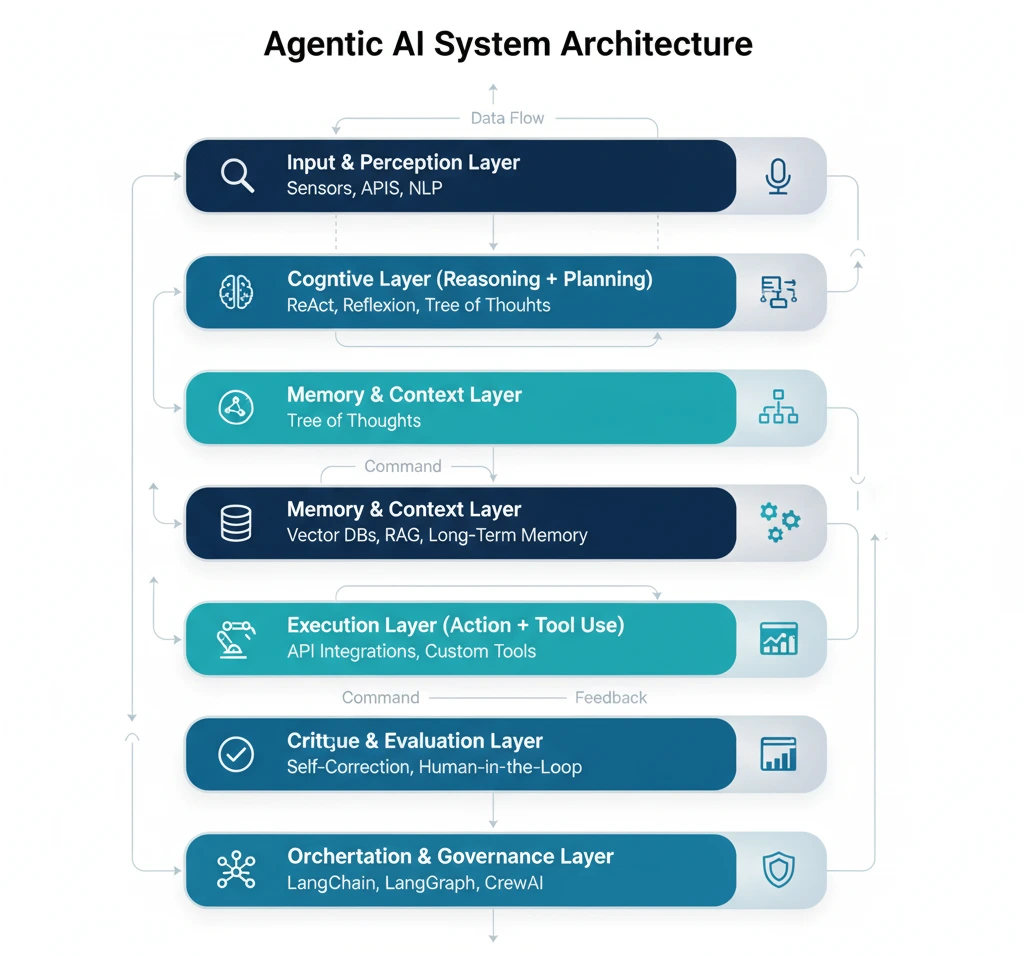
The Role of Memory and Context Windows
Memory is what makes an agent self-aware.
It preserves the history of perceptions, actions, and reflections, allowing continuity of thought.
Two main forms of memory are used:
- Short-Term Context Windows – maintain immediate conversational or operational relevance for in-progress reasoning.
- Long-Term Vector Memory – stores embeddings of past experiences for retrieval and reuse.
Modern frameworks such as LangGraph or GraphRAG embed both, enabling agents to draw on prior knowledge while reasoning about new inputs.
This contextual grounding prevents “amnesia” and drastically improves decision coherence.
Multi-Agent Orchestration
In complex deployments, dozens or even thousands of agents operate simultaneously.
An orchestrator ensures they collaborate instead of competing.
It manages dependencies, communication channels, and global objectives.
Typical orchestration workflows include:
- Task Allocation: assigning subtasks to specialized agents.
- Inter-Agent Messaging: enabling knowledge sharing and coordination.
- Conflict Resolution: preventing contradictory actions.
- Performance Tracking: logging metrics and feedback for continuous optimization.
Frameworks such as CrewAI and LangGraph provide these orchestration features through graph-based task scheduling and event-driven pipelines.
The Critic and Evaluation Subsystem
No agentic system is complete without a Critic Agent, a self-review mechanism that evaluates outputs for accuracy and alignment.
This layer uses models trained for quality assurance and error detection to verify results before execution or publication.
It introduces accountability inside the system, echoing human peer-review processes.
By integrating Reflexion-style evaluation loops, the agentic network maintains reliability and reduces cascading errors.
Observability and Governance in Architecture
For enterprises, observability isn’t optional, it’s integral.
An observability layer tracks:
- Reasoning Traces: each decision path and rationale.
- Memory State Logs: what data was retrieved or modified.
- API Call Audits: which external systems were accessed.
- Policy Compliance Checks: whether actions align with governance rules.
Combining observability with governance ensures that autonomy doesn’t mean opacity.
Systems like Semantic Kernel include policy hooks and permission models to keep human oversight in the loop.
Architectural Benefits
- Scalability: Each agent or module scales independently across cloud or on-prem environments.
- Transparency: Decision paths and memory states are fully auditable.
- Resilience: Failures are isolated; one agent’s fault doesn’t collapse the system.
- Interoperability: Frameworks can integrate through APIs and data standards.
- Adaptability: Modules evolve as models or goals change.
This flexibility positions agentic systems as the blueprint for long-term enterprise AI infrastructure.
Frameworks and Reasoning Patterns in Agentic AI
Why Frameworks Matter
Building an agentic system isn’t only about deploying an LLM it’s about constructing a thinking environment.
Frameworks define how agents reason, collaborate, and learn.
They determine whether the system can plan long sequences, recover from errors, or work with other agents across domains.
In short, frameworks translate autonomy into architecture.
Every framework implements three universal abilities:
- Cognitive Reasoning – how the agent forms and evaluates thoughts.
- Task Orchestration – how it coordinates with peers and tools.
Learning and Adaptation – how it reflects on outcomes and improves over time.
Core Reasoning Patterns
ReAct (Reason + Act)
The ReAct pattern alternates between reasoning and execution.
An agent pauses after each action to evaluate new context before moving on much like a scientist testing a hypothesis, observing results, then deciding the next step.
This loop is ideal for environments requiring rapid context shifts such as web navigation, data retrieval, or IT troubleshooting.
Reflexion
Reflexion introduces meta-cognition: after producing an output, the agent critiques its own reasoning and revises the response if needed.
This self-evaluation mechanism improves factual accuracy and reliability making it indispensable for code generation, research summarization, or knowledge synthesis.
Tree of Thoughts (ToT)
The Tree of Thoughts approach lets an agent explore multiple solution paths in parallel.
It compares these “thought branches” and converges on the most promising route.
ToT is especially powerful in strategic planning, decision-making under uncertainty, or multi-variable optimization.
Plan-and-Execute
Here, the agent designs a comprehensive plan first, then executes each step sequentially.
This method emphasizes structure and traceability well-suited for enterprise automation, software testing, or project orchestration pipelines.
Critic–Refine
In this dual-agent pattern, a critic reviews outputs before finalization.
It introduces an internal quality-control layer that detects logical gaps or hallucinations, particularly valuable in document generation, legal summarization, and creative production.
Each reasoning pattern models a different aspect of human cognition: reflection, branching, collaboration, or discipline enabling you to choose the most suitable approach for your goals.
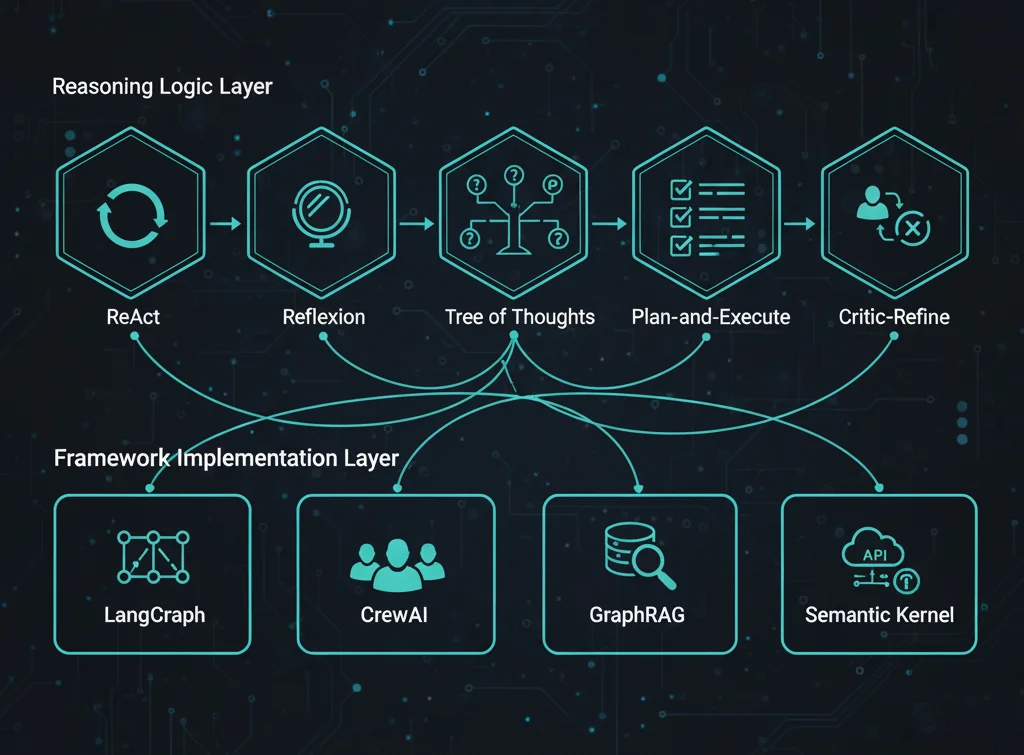
Leading Frameworks Powering Agentic Systems
LangGraph
LangGraph uses graph-based reasoning, where each node represents a reasoning step or tool call.
It allows developers to visualize and trace an agent’s decision path, ensuring transparency and debuggability.
LangGraph’s asynchronous architecture makes it a strong choice for multi-agent ecosystems that require concurrency, memory persistence, and state management.
CrewAI
CrewAI focuses on team intelligence.
Instead of one monolithic model, you orchestrate a crew of specialized agents, researchers, planners, developers, critics each with its own role.
CrewAI coordinates them through role-based collaboration and shared objectives, mirroring how human teams operate.
It excels in enterprise workflows, R&D environments, and cross-domain automation.
GraphRAG
GraphRAG (Graph-based Retrieval-Augmented Generation) extends RAG by using knowledge graphs and semantic embeddings to retrieve facts not by keyword but by concept.
This yields contextually grounded reasoning and reduces hallucination risks.
GraphRAG is ideal for knowledge-heavy enterprises, data-driven assistants, and content research pipelines.
Reflexion and ReAct Implementations
Frameworks such as LangChain, AutoGPT, and OpenDevin integrate Reflexion and ReAct loops directly.
These open-source environments demonstrate how self-critique and incremental reasoning can be combined to achieve autonomous, auditable workflows.
Semantic Kernel
Developed by Microsoft, Semantic Kernel bridges enterprise systems with agentic logic.
It integrates APIs, databases, and governance policies within a single orchestration layer.
This makes it particularly effective for secure, large-scale enterprise deployments where compliance, observability, and scalability are mandatory.
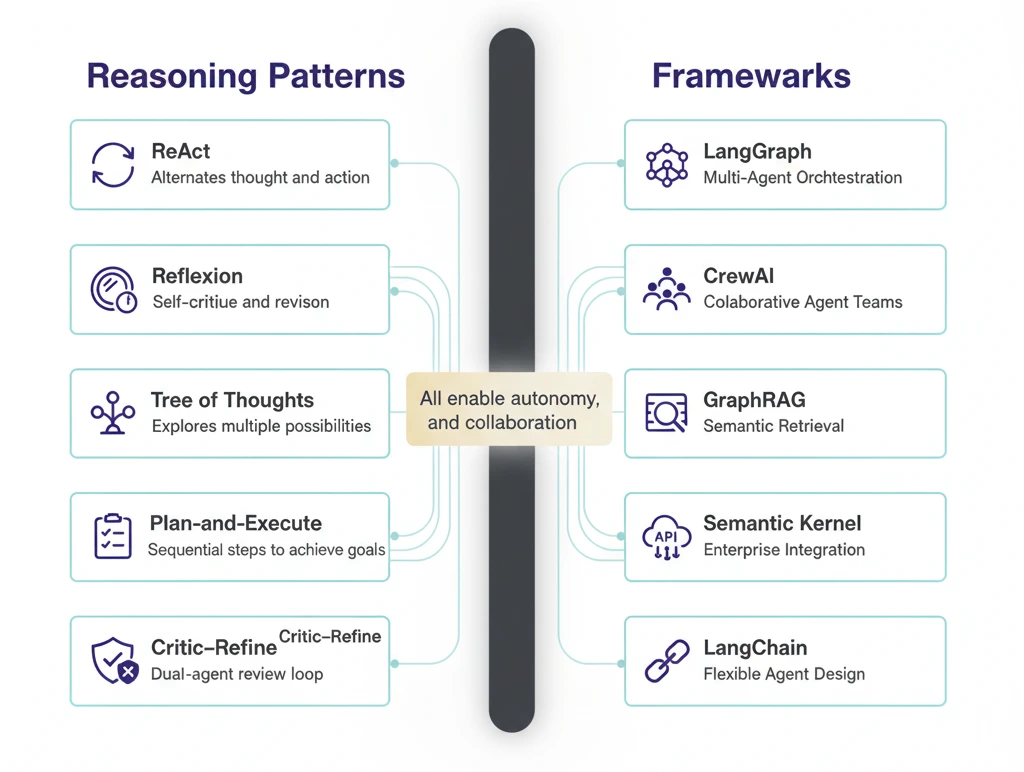
How to Choose the Right Framework
| Goal / Need | Recommended Framework | Key Advantage |
|---|---|---|
| Complex multi-agent workflows | LangGraph | Graph orchestration and transparency |
| Collaborative team simulation | CrewAI | Role-based coordination |
| Knowledge-intensive retrieval | GraphRAG | Semantic graph grounding |
| Iterative self-correction | Reflexion / Critic–Refine | Built-in feedback and reliability |
| Real-time dynamic interaction | ReAct | Stepwise adaptability |
| Enterprise-grade automation | Semantic Kernel | Governance + API integration |
Pro Tip: Many advanced systems mix frameworks e.g., LangGraph + Reflexion for self-auditing orchestration, or CrewAI + GraphRAG for collaborative, knowledge-aware agents.
Best Practices for Implementing Frameworks
- Prototype first. Validate the reasoning loop (perceive → plan → act → learn) before scaling.
- Design modularly. Treat reasoning patterns as interchangeable plugins.
- Embed observability. Log reasoning traces and memory state from day one.
- Combine strategically. Hybrid frameworks often outperform single-pattern setups.
Keep humans in the loop. Maintain checkpoints for ethics, governance, and oversight.
In Essence
Frameworks and reasoning patterns are the nervous system of Agentic AI.
They determine whether an agent merely reacts or truly thinks, collaborates, and improves.
Selecting the right framework means balancing autonomy with control, speed with transparency, and innovation with governance.
When designed well, these systems transform language models into intelligent digital colleagues that reason, act, and evolve responsibly.
Agentic AI vs Generative AI vs Traditional AI
Understanding the Evolutionary Spectrum
To appreciate what makes Agentic AI distinct, it helps to see how it evolved from earlier forms of artificial intelligence.
Each generation of AI reflects a new layer of capability:
- Traditional AI automated static, rule-based tasks.
- Generative AI created new content from patterns.
- Agentic AI acts on that content, applying reasoning and learning to achieve goals autonomously.
This evolution mirrors the progression from automation to creativity to autonomy.
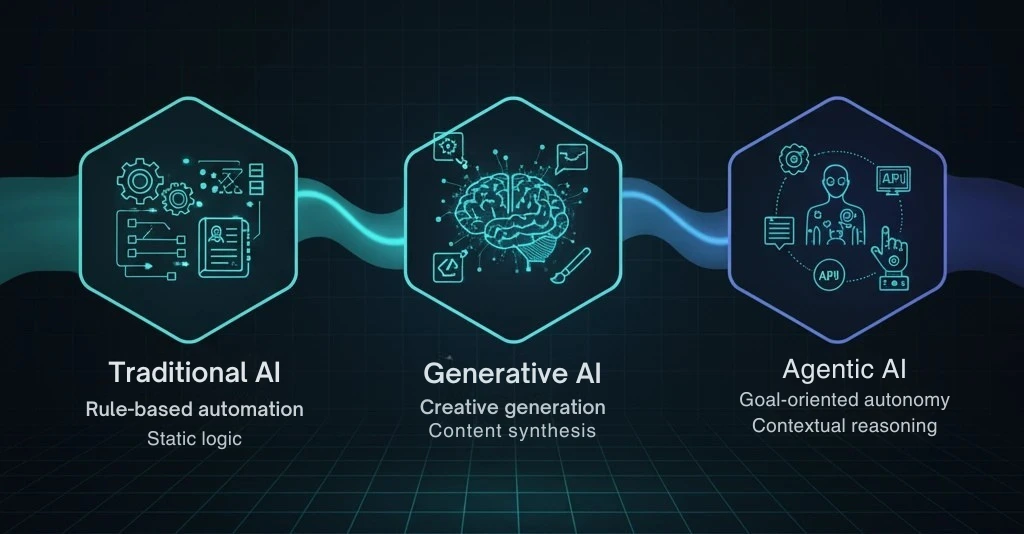
Traditional AI: Rule-Based and Reactive
Traditional AI refers to early systems that relied on explicit instructions and predefined logic.
These models, often built on expert systems or if–then rules, could only perform narrow, predictable tasks.
Examples include:
- Spam filters that categorize emails based on preset criteria.
- Robotic Process Automation (RPA) that executes repetitive workflows.
- Recommendation engines that predict outcomes without adapting to new contexts.
While effective for routine processes, traditional AI systems lack adaptability. They can’t learn beyond their initial programming, making them brittle in dynamic environments.
Generative AI: The Creative Transformer
Generative AI marked a huge leap by enabling machines to create text, code, images, and even music.
Powered by Large Language Models (LLMs) and transformer architectures, this generation introduced context-aware generation and conversational fluency.
Key breakthroughs included:
- Pretraining + Fine-tuning: LLMs like GPT and Claude trained on massive corpora to predict and generate coherent sequences.
- Zero-shot and Few-shot learning: Models could generalize to unseen prompts.
- Multimodality: Integration of text, image, and audio generation.
Generative AI transformed creative industries, marketing, and software prototyping.
But it remained reactive; it only acted when prompted and could not execute autonomous decisions.
Agentic AI: From Generation to Action
Agentic AI extends the generative foundation into autonomy.
It uses reasoning frameworks, memory, and orchestration to perceive context, plan, and act without direct instruction.
In other words:
Generative AI creates. Agentic AI decides and acts.
Agentic systems connect LLMs to external tools, APIs, and databases, allowing them to complete real-world tasks.
For instance, rather than just writing code, an agentic system can test, debug, and deploy it.
Core properties include:
- Goal-Directed Autonomy: Agents pursue defined objectives, not just outputs.
- Contextual Reasoning: Continuous analysis of feedback and changing conditions.
- Tool Use and Orchestration: Integration with APIs, databases, and knowledge graphs.
- Self-Learning: Refinement through feedback loops and reinforcement learning.
This turns AI from a creative assistant into an independent collaborator.
Comparative Overview: Traditional vs Generative vs Agentic AI
| Feature | Traditional AI | Generative AI | Agentic AI |
|---|---|---|---|
| Primary Function | Automates rule-based tasks | Creates new content (text, code, media) | Acts toward goals and executes tasks |
| Learning Type | Supervised or static ML | Generative pretraining & fine-tuning | Reinforcement learning + orchestration |
| Autonomy Level | Low | Medium | High |
| Context Awareness | Minimal | Moderate | Deep reasoning and feedback awareness |
| Adaptability | None | Reactive | Proactive and evolving |
| Decision-Making | Deterministic | Contextual generation | Goal-driven reasoning |
| Examples | Spam filter, RPA bots | ChatGPT, Midjourney | LangGraph Agents, CrewAI orchestration systems |
| Output Nature | Fixed or repetitive | Creative and expressive | Dynamic, adaptive, and actionable |
Why Agentic AI Represents the Next Frontier
Agentic AI isn’t a replacement for generative AI, it’s the next layer.
Generative models produce; agentic systems apply those outputs, act on them, and learn from the results.
This shift delivers three transformative benefits:
- Closed Cognitive Loop: Perception → Reasoning → Action → Learning.
- Enterprise Integration: Tools, APIs, and workflows connected end-to-end.
- Autonomous Optimization: Continuous improvement without retraining.
In practical terms, this means a chatbot evolves into a digital employee capable of analyzing a request, researching answers, executing tasks, and improving with experience.
The Synergy Between Generative and Agentic AI
Generative and Agentic AI are complementary, not competitive.
They coexist as layers in the same intelligence stack:
- Generative AI provides creativity, language understanding, and content generation.
- Agentic AI adds autonomy, goal pursuit, and multi-step execution.
For instance:
A generative model might draft marketing copy, while an agentic system automatically tests variations, measures engagement, and iterates for better results.
This synergy marks the transition from AI that responds to AI that collaborates.
The Business Implications of the Shift
For organizations, adopting Agentic AI unlocks:
- Operational Autonomy: Systems that execute workflows without supervision.
- Decision Intelligence: AI that not only reports metrics but acts on them.
- Scalable Productivity: A digital workforce capable of continuous operation.
Businesses that adapt early will lead the new era of digital labor where intelligent agents coordinate work, manage processes, and free human teams to focus on creativity and strategy.
Benefits of Agentic AI
A New Paradigm of Autonomy and Intelligence
The arrival of Agentic AI represents more than just a technical milestone; it redefines how digital systems interact with data, people, and goals.
Unlike traditional automation or generative assistants, agentic systems can think strategically, act independently, and evolve through feedback.
Their benefits are both operational and cognitive, spanning productivity, adaptability, creativity, and human collaboration.
True Autonomy and Operational Efficiency
Agentic systems don’t just follow instructions, they pursue outcomes.
By combining reasoning frameworks (like ReAct or LangGraph) with orchestration and memory, these agents can manage multi-step workflows without continuous human oversight.
- They identify goals, plan actions, and execute them across tools and APIs.
- Routine monitoring or follow-ups happen automatically through memory modules.
- Human intervention only occurs when governance or ethics require it.
For enterprises, this translates into fewer repetitive tasks, faster execution, and significant cost reduction.
Teams can focus on creative and strategic work while agents handle the process-heavy operations in the background.
Adaptive and Scalable Intelligence
Unlike static models that degrade over time, Agentic AI learns continuously.
Every decision and outcome becomes data for improvement.
Using reinforcement learning, agents experiment, measure, and adapt to changing conditions whether that’s customer behavior, system failures, or new data streams.
At scale, multi-agent orchestration frameworks like CrewAI or LangGraph enable hundreds of agents to collaborate fluidly.
This distributed intelligence allows organizations to scale decision-making capacity dynamically growing smarter, not just bigger.
Human–AI Collaboration and Empowerment
Agentic AI doesn’t replace people; it augments them.
Through natural language interfaces, humans can communicate intentions, while agents translate those intentions into precise workflows.
Imagine a project manager asking, “Prioritize all open tickets related to authentication issues.”
The agent doesn’t just list them, it assigns tasks, updates dashboards, and triggers notifications automatically.
This symbiotic collaboration enables humans to remain decision-makers while agents execute, verify, and optimize.
It’s a future of human-centered autonomy, where machines work with empathy, not just efficiency.
Workflow Optimization and Process Intelligence
Modern enterprises are built on complex, interconnected workflows CRM systems, ERP data, marketing platforms, and more.
Agentic AI acts as a universal coordinator between these silos.
By integrating through APIs and orchestration frameworks, agents can:
- Synchronize data across multiple systems.
- Identify and resolve workflow bottlenecks.
- Trigger cross-department actions automatically.
With observability tools like Semantic Kernel or GraphRAG, every step of an agent’s reasoning is logged, making automation transparent and auditable.
The result: higher accuracy, less downtime, and improved compliance without sacrificing speed.
Innovation Enablement and Knowledge Discovery
Agentic AI doesn’t just automate, it innovates.
By using knowledge graphs and semantic retrieval, it can discover insights hidden in enterprise data.
Agents can connect seemingly unrelated information, generate hypotheses, or even propose new strategies based on evidence.
For research and development teams, this means accelerating ideation cycles and transforming how innovation happens:
- In pharmaceuticals, agents can surface drug interaction patterns.
- In finance, they can detect emerging market opportunities.
- In education, they can personalize learning pathways dynamically.
Agentic AI becomes not just a tool but a thinking partner, helping humans extend their intellectual reach.
Strategic Agility and Continuous Improvement
Agentic systems thrive in environments of uncertainty.
Through built-in feedback loops, agents continually refine their strategies, optimizing for accuracy, time, and resources.
This adaptability creates what Koray’s semantic SEO calls temporal topical authority staying relevant as contexts change.
For businesses, it ensures that the AI grows smarter alongside organizational evolution, not stale or outdated.
Ethical and Transparent Decision-Making
With great autonomy comes great responsibility.
Agentic AI introduces mechanisms for traceability: every decision can be traced back through reasoning chains, data sources, and evaluation steps.
Governance frameworks ensure that autonomy doesn’t become opacity.
This transparency builds trust with both internal teams and external users, a cornerstone for sustainable AI adoption.
Economic and Competitive Advantage
By deploying autonomous agents as digital coworkers, businesses can reduce operational costs while expanding capacity.
This new class of digital labor can handle repetitive yet cognitively complex tasks data analysis, testing, auditing, or compliance tracking.
Companies that embrace this shift early will gain a compounding competitive advantage through faster execution, continuous innovation, and lower time-to-value.
The Broader Impact: From Productivity to Purpose
The true benefit of Agentic AI isn’t just the speed of its transformation.
It changes how work happens.
By integrating learning, reasoning, and action into a continuous loop, organizations transition from reactive execution to proactive innovation.
This shift redefines productivity from doing more to doing better intelligently, ethically, and sustainably.
Real-World Use Cases of Agentic AI
From Concept to Capability
Agentic AI is no longer a research topic, it’s an operational force.
Across industries, organizations are moving from reactive chatbots and fixed automation toward autonomous, context-aware agents that collaborate, learn, and optimize in real time.
These systems demonstrate how autonomy, reasoning, and orchestration can create measurable business impact.
Customer Service and Support
Customer experience is one of the fastest-growing frontiers for Agentic AI adoption.
An autonomous service agent can manage an entire support ticket lifecycle:
- Understand a customer query through natural language.
- Retrieve relevant answers from a knowledge base using RAG or GraphRAG.
- Take direct action for example, issuing a refund or updating an account via API.
- Follow up with context-aware communication to close the loop.
Unlike traditional chatbots that follow scripts, agentic systems perceive intent, reason about context, and act.
They also feed outcomes back into memory, improving tone, accuracy, and empathy over time.
Supply Chain and Logistics
In supply chains, every delay ripples across production and distribution.
Agentic AI uses multi-agent coordination to predict disruptions, rebalance resources, and optimize logistics end-to-end.
For example:
- A monitoring agent detects a delay in shipping data.
- A planner agent recalculates routes and updates delivery ETAs.
- A communications agent alerts partners and customers automatically.
This real-time orchestration increases resilience, reduces costs, and minimizes human intervention while keeping operations transparent and traceable.
Healthcare and Life Sciences
In healthcare, agentic systems act as intelligent intermediaries between medical data and clinical decision-making.
They can:
- Analyze patient records to suggest personalized treatments.
- Flag anomalies in medical imaging.
- Assist in drug discovery by synthesizing trial data.
Through human-in-the-loop governance, clinicians remain in control while agents handle computation and retrieval.
Compliance modules ensure alignment with privacy regulations such as HIPAA or GDPR, making automation both effective and ethical.
Finance and Banking
Financial institutions are integrating agentic agents into risk management and operations.
These systems autonomously monitor transactions, identify anomalies, and flag suspicious activity for review.
They can also assist analysts by:
- Generating portfolio reports from live market data.
- Simulating investment scenarios through reinforcement learning.
- Optimizing credit decisions while ensuring fairness and transparency.
Agentic AI enhances trust and speed in financial decision-making, reducing human error while retaining regulatory control.
IT Operations and Software Development
In IT and engineering, agentic systems act as autonomous co-developers and incident responders.
- A monitoring agent detects an outage and initiates diagnostic scripts.
- A fix agent executes safe rollbacks or deploys patches.
- A documentation agent summarizes the incident and updates the knowledge base.
Frameworks like OpenDevin and LangGraph enable collaborative “AI teams” that write code, review pull requests, and continuously learn from deployment feedback.
This reduces downtime and makes engineering teams far more productive.
Marketing and Personalization
In marketing, agentic AI goes beyond content generation to complete campaign execution.
A creative agent can write copy and generate visuals using Generative AI, while an orchestration agent tests audience segments, tracks metrics, and iterates campaigns in real time.
By integrating with customer data platforms and Data Cloud systems, these agents deliver hyper-personalized marketing journeys that continuously optimize for engagement and conversion.
Education and Knowledge Management
Agentic AI redefines learning by creating personalized educational experiences.
Agents analyze student performance data, recommend custom learning paths, and update curricula based on progress.
In enterprise settings, they transform static knowledge bases into dynamic training ecosystems, making organizational learning adaptive and on-demand.
Cross-Domain Innovation
Some of the most exciting use cases emerge where domains overlap. For example:
- In smart manufacturing, agents coordinate between sensors and ERP systems for real-time production optimization.
- In urban planning, they simulate traffic flows and energy consumption using synthetic data for policy testing.
Cross-domain agentic systems show how AI can act as the connective tissue between data, tools, and people across industries.
The Common Thread: Autonomy in Action
Across all these industries, one theme repeats: goal-driven autonomy.
Agents observe, reason, and act within governed boundaries turning static processes into living, self-improving systems.
This marks the moment when AI transitions from “assisting humans” to collaborating with humans to reshape entire business models.
Governance, Risks, and Ethical Considerations
Balancing Autonomy with Accountability
As Agentic AI systems gain autonomy, they also inherit new forms of risk.
When AI agents can make decisions, take actions, and influence workflows, trust and control become as important as performance.
Without governance, these systems can become unpredictable, biased, or even unsafe.
Governance in Agentic AI is the structure that ensures autonomy remains aligned with human values, legal frameworks, and organizational goals.
It’s the guardrail that allows independence without chaos turning free-thinking agents into reliable digital citizens.
The Black Box Problem: Explainability and Transparency
One of the most pressing challenges in Agentic AI is understanding how and why a system reaches a decision.
Complex models, especially multi-agent orchestration networks can behave in ways that are difficult to interpret.
Without explainability, it’s impossible to audit or correct mistakes.
This is often referred to as the black box problem: decisions go in, results come out, but the reasoning remains hidden.
Solutions include:
- Embedding observability layers that record reasoning chains, tool calls, and intermediate states.
- Using explainable AI methods to visualize how agents reach conclusions.
- Implementing traceable memory systems that store every step of the perception–reasoning–action loop.
Transparency builds confidence not only for engineers and regulators, but also for the users who rely on agentic systems daily.
Security and Privacy: Protecting Sensitive Data
Autonomous agents often operate across sensitive environments HR records, finance systems, and medical databases.
A single misconfigured tool call or memory leak can expose private data.
That’s why Agentic AI governance must enforce security by design, ensuring agents:
- Operate in sandboxed environments where actions are restricted.
- Use granular access control to prevent unauthorized system calls.
- Employ end-to-end encryption for all data transmissions.
- Maintain compliance with frameworks like GDPR, HIPAA, or SOC 2.
The goal is to balance capability with containment enabling useful autonomy while minimizing exposure.
Bias and Fairness: Ethical Intelligence in Action
Agentic AI learns from data, and data often carries human bias.
If left unchecked, these biases can manifest as discriminatory outcomes in hiring, lending, or service delivery.
To address this:
- Conduct data audits before training to identify potential bias sources.
- Include diverse datasets to prevent overfitting to narrow demographics.
- Apply fairness scoring models to evaluate decision outcomes.
- Introduce ethical governance councils that review AI behavior periodically.
A fair AI system is not just a moral choice, it’s a performance advantage.
Bias reduction leads to more accurate, inclusive, and trustworthy AI decisions.
Human Oversight: The Human-in-the-Loop Imperative
Even the most advanced agentic systems need human supervision.
Human-in-the-loop (HITL) structures allow people to validate outputs, review critical decisions, and step in when anomalies occur.
This hybrid model ensures autonomy remains accountable.
Humans guide intent, monitor boundaries, and inject judgment where context exceeds machine understanding.
Typical human oversight checkpoints include:
- Approval gates: Agents must seek confirmation for high-impact actions.
- Error escalation: Failed or ambiguous decisions are routed to humans.
- Periodic audits: Human reviewers examine logs and performance trends.
HITL doesn’t slow AI down, it stabilizes it, creating a continuous loop of feedback, learning, and trust.
Integration Complexity and Systemic Risk
Integrating agentic systems with existing enterprise infrastructure introduces both technical and organizational complexity.
Without proper orchestration and modular design, independent agents can behave unpredictably, competing for resources or triggering redundant workflows.
Mitigation strategies include:
- Using modular architecture to isolate functions.
- Implementing governed orchestration layers like Semantic Kernel for cross-agent coordination.
- Maintaining clear role definitions for each agent planner, critic, retriever, or executor.
This ensures scalability without chaos autonomy within structure.
Ethical Governance and Accountability
Ethical AI requires clear accountability. Who is responsible when an autonomous system makes a mistake?
Organizations must define ownership not just for AI outputs but for the decision-making process itself.
Modern governance frameworks like EU AI Act, NIST AI Risk Management Framework, and OECD AI Principles emphasize:
- Transparency in AI decision logic.
- Traceability of actions and data sources.
- Accountability through clear human oversight chains.
Embedding these principles into the design phase ensures ethical alignment is not an afterthought but a foundation.
Building Trust Through Observability
Observability transforms AI from a black box into a glass box.
With real-time monitoring of memory states, reasoning patterns, and action outcomes, organizations gain visibility into how agentic systems operate.
This observability framework is the cornerstone of AI safety allowing continuous auditing, performance evaluation, and bias correction at scale.
When users understand why an AI acted, they’re far more likely to trust that it acted correctly.
The Responsible Path Forward
Governance isn’t the end of innovation, it’s what enables it safely.
By aligning autonomy with ethical and legal boundaries, organizations ensure that their AI systems not only work efficiently but also act responsibly.
Agentic AI, when guided by human values and transparent design, can become one of the most trustworthy technological advances of our time.
Observability and Safety in Agentic Systems
Why Observability Matters for Autonomous Intelligence
Agentic AI brings decision-making power to machines but with that power comes uncertainty.
Observability provides a transparent window into how agents think, act, and learn.
Just as engineers monitor cloud infrastructure, AI developers must monitor cognition: what data agents use, which tools they call, and why specific decisions occur.
Observability bridges the gap between autonomy and accountability transforming AI from a black box into a glass box.
Defining Observability in Agentic AI
In an agentic architecture, observability refers to the ability to:
- Trace every decision step within the Perception → Reasoning → Action loop.
- Log interactions between modules such as memory, retriever, and planner.
- Visualize performance metrics to evaluate decision quality.
Unlike traditional logging, observability captures semantic context the why behind the what.
This insight allows developers to diagnose failures, measure reasoning quality, and continuously refine the agent’s cognitive architecture.
Key Signals That Define a Safe Agentic System
Effective observability involves monitoring several signal layers:
- Decision Traces – Track reasoning paths and justification chains for each action.
- Memory States – Record what the system remembers or forgets between sessions.
- Tool Invocations – Log external API and function calls for transparency.
- Error Rates and Recovery – Measure failure frequency, cause, and correction success.
Together, these create a behavioral map of the agent, enabling fine-grained control and post-hoc analysis.
Safety Through Real-Time Monitoring and Alerts
Safety in agentic systems relies on proactive surveillance.
Agents can be equipped with guardrails automated triggers that stop unsafe or unexpected actions.
For instance:
- If an AI agent tries to access a restricted database, a safety rule can intercept and quarantine the action.
- If response confidence drops below a threshold, the system escalates to human review.
By combining anomaly detection with contextual observability, organizations maintain control even when agents act autonomously.
Memory Auditing and Temporal Accountability
Because Agentic AI systems rely on memory to learn from experience, auditing that memory becomes crucial.
Every stored embedding, conversation, or retrieval must be timestamped and traceable.
Temporal logs help detect when:
- Old or irrelevant data distorts reasoning.
- Sensitive information is stored beyond retention policies.
- Feedback loops reinforce bias instead of correcting it.
Through temporal observability, agents gain not only intelligence but integrity.
Observability Frameworks and Tools
Modern frameworks now integrate observability as a native layer:
- Semantic Kernel provides event tracing for orchestration workflows.
- LangGraph records reasoning nodes, tool calls, and memory updates as a knowledge graph.
- CrewAI offers agent-level dashboards for collaboration performance metrics.
- GraphRAG visualizes semantic relationships between retrieved facts and agent output.
These tools create end-to-end visibility, making AI behavior explainable not only to engineers but also to compliance teams.
Human Oversight in the Observability Loop
Even the best monitoring systems require a human layer of review.
Human-in-the-loop observability ensures that humans periodically validate logs, review edge cases, and interpret anomalies beyond numerical metrics.
Ethical monitoring committees can assess whether agentic decisions align with business and moral standards reinforcing the partnership between autonomy and responsibility.
From Visibility to Trust: Why Safety Is a Design Principle
Safety shouldn’t be an afterthought added through patches; it must be embedded from design.
When observability, feedback, and guardrails coexist from the start, trust becomes measurable.
Users, regulators, and developers can all see why an agent acted and how it corrected itself.
This transparency transforms AI from an opaque executor into a trusted collaborator.
The Future of Agentic AI: From Digital Assistants to Digital Labor
A New Epoch in Human–Machine Collaboration
Artificial intelligence is evolving from assistance to autonomy from following commands to shaping outcomes.
If Generative AI was the creative catalyst, Agentic AI is the operational revolution.
The next phase of this transformation introduces a new concept: Digital Labor intelligent agents capable of independently performing complex, multi-step tasks that were once the sole domain of humans.
These agents won’t simply help humans work faster; they’ll redefine how work is structured.
Organizations will shift from managing human processes to orchestrating ecosystems of autonomous agents, humans, and robotic systems working together toward shared goals.
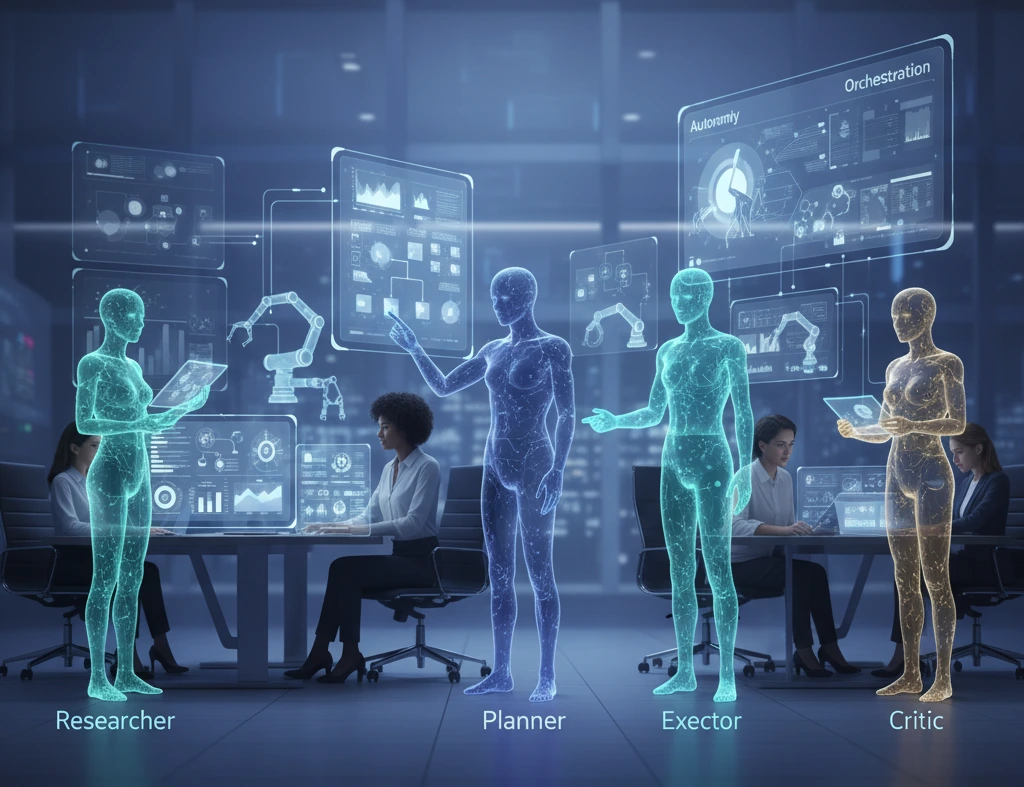
1. Multi-Agent Ecosystems: AI Teams That Collaborate Like Humans
Tomorrow’s enterprises will deploy teams of specialized agents each with a defined role.
For example:
- A Research Agent gathers data and insights.
- A Planner Agent designs workflows.
- An Executor Agent carries out actions through APIs or RPA bots.
- A Critic Agent reviews results and proposes improvements.
Frameworks like CrewAI and LangGraph already demonstrate this multi-agent orchestration.
These systems simulate human collaboration, with agents communicating, delegating, and refining outcomes through continuous dialogue.
In this model, the enterprise becomes a living network of AI collaborators, where human and digital minds coexist productively.
2. Continuous Learning Systems: Intelligence That Evolves Over Time
Traditional AI models degrade as environments change but Agentic AI evolves.
By combining reinforcement learning, memory persistence, and retrieval-augmented reasoning, agents can learn from outcomes and improve autonomously.
These systems maintain a feedback-driven cycle:
Observe → Act → Reflect → Improve.
This closed loop turns digital agents into self-improving entities, capable of optimizing not just tasks but entire business workflows.
Over time, organizations adopting continuous learning systems will see exponential improvements in speed, quality, and insight generation.
3. Human–AI Symbiosis: The Redefinition of Work
The most profound shift isn’t technological, it’s cultural.
Agentic AI represents the birth of symbiotic intelligence, where humans and machines complement one another’s strengths.
Humans excel at creativity, ethics, and empathy.
AI agents excel at precision, memory, and execution.
Together, they form a collaborative cognitive network that redefines productivity.
A human marketing strategist might guide brand vision, while an AI agent autonomously manages campaign operations, continuously learning from results.
This hybrid approach ensures that autonomy never replaces humanity; it enhances it.
4. Enterprise Transformation: From Management to Orchestration
As agentic systems mature, businesses will evolve from process management to process orchestration.
Executives will no longer ask, “How can humans do this faster?” but rather, “How can agents and humans do this better together?”
Enterprise orchestration will focus on:
- Assigning goals to autonomous teams of agents.
- Monitoring outcomes via observability dashboards.
- Governing ethics, compliance, and performance at scale.
This marks the shift from linear hierarchies to adaptive, self-optimizing networks organizations that evolve dynamically as market conditions change.
5. Industry Horizons: The Coming Wave of Agentic Innovation
Agentic AI’s impact will span every major sector:
- Healthcare: AI care coordinators will automate diagnostics and manage patient data.
- Finance: Digital analysts will autonomously handle portfolios and risk reports.
- Education: Personalized tutors will guide each learner’s path through adaptive feedback.
- Manufacturing: Intelligent agents will synchronize machines and logistics across factories.
- Public Sector: Policy simulation agents will test legislation outcomes using real-world data.
By 2030, digital labor ecosystems could become as common as enterprise software is today transforming how productivity, employment, and innovation are measured.
6. The Ethical and Societal Implications of Digital Labor
While agentic systems promise growth, they also raise questions about responsibility, regulation, and equity.
Organizations must define:
- Who is accountable when digital labor makes a mistake?
- How will human roles evolve when machines manage cognitive work?
- What frameworks will ensure transparency, fairness, and human dignity?
Embedding AI ethics and human governance into every digital labor ecosystem ensures that the future of autonomy remains aligned with societal values.
7. The Next Frontier: Autonomous, Transparent, and Accountable Intelligence
The next decade will see Agentic AI evolve beyond reactive automation into purposeful, transparent intelligence.
These systems will:
- Operate with explainable reasoning.
- Maintain continuous self-assessment.
- Collaborate fluidly with humans.
The ultimate vision isn’t machines replacing people, it’s humans and machines co-creating value.
Agentic AI is the foundation of that future. It transforms intelligence from a tool into a trusted partner capable of learning, reasoning, and improving alongside us.
Learning Pathways and Career Roadmap
Why Agentic AI Skills Matter Now
Agentic AI isn’t just a new framework, it’s a shift in how software, systems, and people collaborate.
Organizations need professionals who can design, orchestrate, and govern these autonomous systems.
Those who master the intersection of reasoning AI, automation, and ethical governance will shape the next decade of intelligent infrastructure.
This section helps you understand what to learn, where to start, and which career roles are emerging around agentic AI.
Foundational Skills to Build First
Start with the fundamentals that power every agentic system:
- Machine Learning & Statistics: Understand how models learn from data, optimize outcomes, and manage uncertainty.
- Natural Language Processing (NLP): Learn how agents interpret and generate human language.
- Deep Learning & LLMs: Study architectures such as Transformers and attention mechanisms the cognitive backbone of reasoning agents.
Courses from platforms like Coursera, Fast.ai, or DeepLearning.ai are ideal for this foundation.
Next-Level Competencies: Reasoning and Orchestration
Once you understand model behavior, move into agentic reasoning and orchestration the unique layer that differentiates this field.
Key areas to master:
- Prompt Engineering & Chain of Thought: Guide LLMs to reason step-by-step.
- Orchestration Frameworks: Experiment with LangGraph (graph-based reasoning), CrewAI (team-based agent coordination), GraphRAG (semantic retrieval), and Semantic Kernel (API integration).
- Tool Use & Memory Management: Learn how agents call APIs, store context, and retrieve knowledge efficiently.
Hands-on experience with open-source repositories and sandbox environments builds credibility fast.
Ethical and Governance Foundations
Technical fluency alone isn’t enough. Agentic AI professionals must understand responsibility, fairness, and compliance.
Study frameworks such as the EU AI Act, NIST AI RMF, and OECD AI Principles.
Learn how to:
- Design Human-in-the-Loop workflows.
- Conduct bias audits and transparency reports.
- Integrate ethical review into deployment pipelines.
Mastery here makes you indispensable in regulated industries.
Applied System Design and Integration
Agentic AI runs on integration.
Develop skills in connecting models to enterprise infrastructure:
- Build APIs that allow agents to communicate securely.
- Use vector databases (Pinecone, Weaviate, FAISS) for contextual memory.
- Deploy agents on cloud platforms with governed access controls.
This technical proficiency bridges AI research and real-world enterprise use.
Specialized Career Roles in Agentic AI
As the field expands, several niche roles are emerging:
| Role | Primary Focus | Core Skills |
|---|---|---|
| AI Orchestration Engineer | Design multi-agent systems and tool integration | LangGraph, Semantic Kernel, APIs |
| Cognitive Architect | Map reasoning frameworks and feedback loops | GraphRAG, Reflexion, data governance |
| Agentic Workflow Designer | Create task pipelines for enterprise automation | CrewAI, RPA, UX design |
| Ethical AI Specialist | Monitor bias, privacy, and accountability | Governance frameworks, policy law |
| Multi-Agent Developer | Build collaborative agents for specific domains | Python, LangChain, ReAct pattern |
These positions bridge AI engineering, operations, and ethics the core pillars of the Agentic AI ecosystem.
Strategic Agility and Continuous Improvement
Agentic systems thrive in environments of uncertainty.
Through built-in feedback loops, agents continually refine their strategies, optimizing for accuracy, time, and resources.
This adaptability creates what Koray’s semantic SEO calls temporal topical authority staying relevant as contexts change.
For businesses, it ensures that the AI grows smarter alongside organizational evolution, not stale or outdated.
Ethical and Transparent Decision-Making
With great autonomy comes great responsibility.
Agentic AI introduces mechanisms for traceability: every decision can be traced back through reasoning chains, data sources, and evaluation steps.
Governance frameworks ensure that autonomy doesn’t become opacity.
This transparency builds trust with both internal teams and external users, a cornerstone for sustainable AI adoption.
Economic and Competitive Advantage
By deploying autonomous agents as digital coworkers, businesses can reduce operational costs while expanding capacity.
This new class of digital labor can handle repetitive yet cognitively complex tasks data analysis, testing, auditing, or compliance tracking.
Companies that embrace this shift early will gain a compounding competitive advantage through faster execution, continuous innovation, and lower time-to-value.
The Broader Impact: From Productivity to Purpose
The true benefit of Agentic AI isn’t just the speed of its transformation.
It changes how work happens.
By integrating learning, reasoning, and action into a continuous loop, organizations transition from reactive execution to proactive innovation.
This shift redefines productivity from doing more to doing better intelligently, ethically, and sustainably.
Conclusion: The Age of Agentic Intelligence
The Transition from Smart Systems to Autonomous Intelligence
Artificial Intelligence has evolved from predictive insights to generative creativity and now, to autonomous reasoning.
Agentic AI marks the next frontier where machines can think, decide, and act independently, guided by purpose rather than just pattern recognition.
These agents don’t simply respond; they participate in the process of creation and decision-making.
They analyze data, plan goals, execute actions, and improve through feedback building a cognitive loop once exclusive to human intelligence.
This shift from reaction to agency represents a foundational change in the way humanity interacts with technology.
Redefining Intelligence as Collaboration
The real power of Agentic AI doesn’t lie in automation it lies in collaboration.
Human insight and AI autonomy can now coexist in an ecosystem of shared cognition.
Humans bring creativity, values, and vision.
Agents bring precision, speed, and persistence.
Together, they form a symbiotic network of intelligence, one that transforms productivity, decision-making, and innovation across every field.
In this new age, the most successful organizations will not replace people with AI but augment them with intelligent systems that continuously learn, reason, and adapt.
Building a Trustworthy AI Future
For Agentic AI to truly flourish, trust and transparency must become as fundamental as data and computation.
This means:
- Embedding observability and governance into every architecture.
- Designing ethical feedback loops with human oversight.
- Ensuring systems remain aligned with organizational and societal values.
The ability to see how and why an AI acts will define its credibility.
In the Age of Agentic Intelligence, trustworthiness becomes the new metric of intelligence.
Preparing for the Next Wave of Digital Transformation
Enterprises, educators, and individuals must now prepare for the era of digital labor and multi-agent ecosystems.
It’s not just another technological upgrade; it’s an organizational evolution.
Those who adapt early will lead in innovation, agility, and operational intelligence.
Those who hesitate risk being left behind in a world where intelligent systems redefine the meaning of efficiency and creativity.
The key isn’t to compete with AI, it’s to collaborate with it.

Final Thoughts: Intelligence That Acts With Purpose
Agentic AI stands as humanity’s bridge to a new kind of intelligence, one that reasons, learns, and acts responsibly.
It’s not just about smarter machines but about more capable societies.
The goal is not replacement but augmentation amplifying human capability through intelligent collaboration.
When designed ethically, orchestrated intelligently, and monitored transparently, Agentic AI can become one of the most empowering technologies of our time.
If you’re exploring how to integrate Agentic AI into your systems or workflows, consider starting with an expert-led knowledge session or strategy consultation.
It’s not a sales pitch, it’s a chance to understand how autonomy and human creativity can evolve together safely and effectively.
You can also follow us on Facebook, Instagram, Twitter, Linkedin, or YouTube.
Frequently Asked Questions
Agentic AI is a form of artificial intelligence that can reason, act, and learn on its own. It uses large language models (LLMs), machine learning, and orchestration frameworks to make decisions and pursue goals with minimal human input.
Traditional AI automates fixed, rule-based tasks, Generative AI creates new content like text or code, and Agentic AI goes further by planning, acting, and adapting to reach defined goals independently.
Agentic AI powers autonomous customer support agents, coding assistants, fraud-monitoring systems, supply-chain optimizers, and healthcare data analyzers that act and learn without step-by-step human control.
ChatGPT alone is a generative model. When connected to tools, APIs, and memory systems through frameworks like LangChain or GraphRAG, it becomes part of an agentic ecosystem capable of taking autonomous actions.
It increases efficiency and scalability by automating complex workflows, improves personalization, enhances human-AI collaboration, and frees teams to focus on creative and strategic work.
Start with machine learning and natural-language processing, explore orchestration frameworks such as LangGraph, CrewAI, or Semantic Kernel, and study reinforcement learning and AI governance best practices.
Agentic AI is moving toward digital-labor ecosystems where autonomous agents collaborate with humans, making decisions, managing workflows, and continuously learning to improve performance.
Key risks include data bias, lack of transparency, and security or privacy vulnerabilities. These are mitigated through governance, observability, and human-in-the-loop oversight.
Popular frameworks include LangGraph, CrewAI, GraphRAG, Semantic Kernel, and LangChain. Each focuses on reasoning, orchestration, or collaboration between multiple agents.
Begin with pilot projects, implement observability and role-based security, keep humans in the loop for oversight, and establish clear ethical and compliance frameworks.

